Glossary
Plant Care Library
F
Fairy Castle Cactus
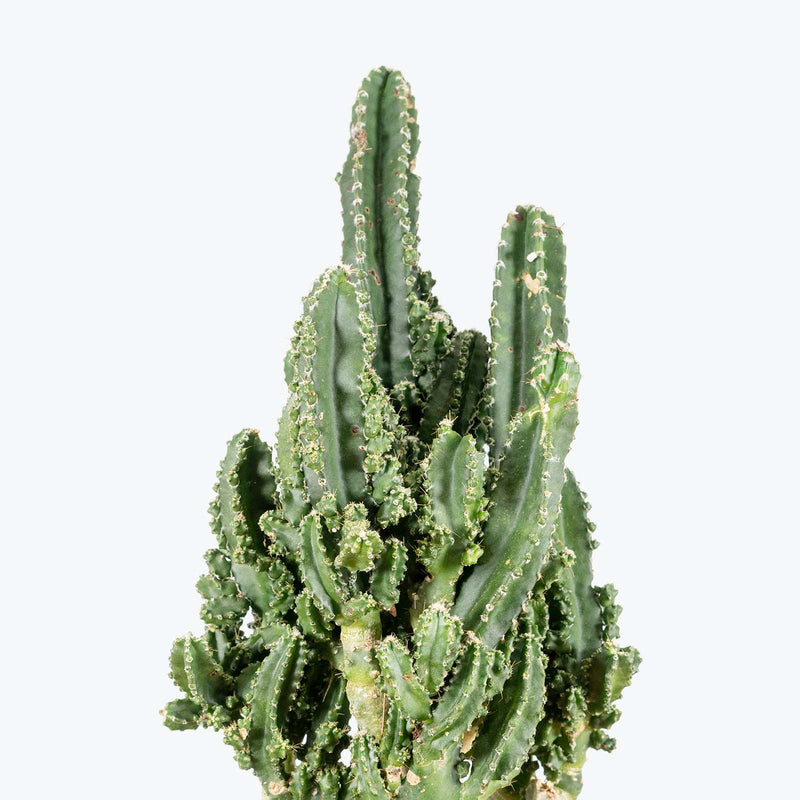
How to care for Fairy Castle Cactus
Fairy Castle Cactus enjoys some direct sun, but they'll also do well in bright, indirect light. It is best to place this plant somewhere where it will receive some nice morning sun, or a couple hours of afternoon sun, and then indirect light the rest of the day.
Fairy Castle Cactus will thrive in bright light, but also can tolerate medium light. A good medium-light place in your home would be in the middle of a room that has a regular size window. They can be placed anywhere between the middle of the room and the window. Remember that plants will grow based on how much light they receive.
Fairy Castle Cactus likes the soil to be completely dry before the next watering. That usually takes about 4 weeks in an average home environment. It will vary depending on the time of year, your environment and lighting conditions, but for them, it's always safer to underwater or water when you see signs of lack of water (i.e. wrinkly or soft leaves). Water a little more often in the warmer months!
Their humidity requirement is low, so do not mist Fairy Castle Cactus or put them in an enclosed terrarium.
As with all succulents, overwatering is sure to be fatal, so err on the side of too dry. Fairy Castle Cactus propagates quite easily from cuttings, simply sever a branch and allow it to dry out and harden before planting. Then, replant the cutting in moist, well-drained soil. Be cautious with fertilization; excessive nutrients can lead to rapid growth that may distort the characteristic compact form of the plant. Ensure the pot has adequate drainage to prevent root rot.
You can feel comfortable having Fairy Castle Cactus around your home in the potential case where your pet feels like nibbling on it. However, we typically recommend keeping your pets from eating any of your houseplants..
Learn MoreView PlantFalse Aralia
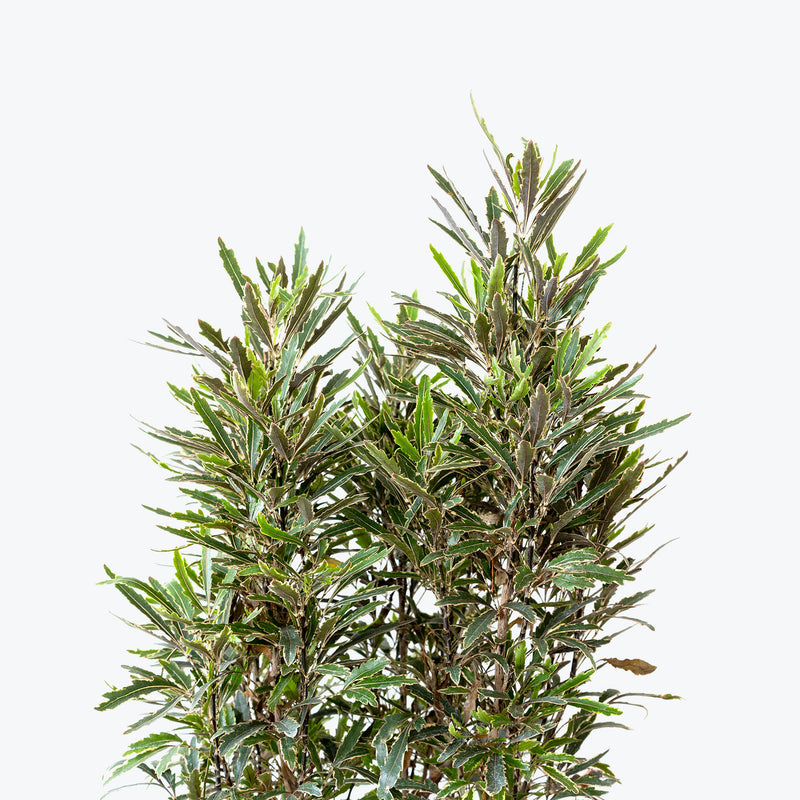
How to care for False Aralia
They should not be in a position to see the sun directly, although early morning or late evening sun is fine. Filtered sunlight through a sheer curtain is best and most homes are comprised primarily of indirect sunlight. The best spot for them is where they do not see the sun during the majority of the day but still get bright, indirect light.
They will do well in medium light but will grow faster with brighter light. A good medium-light place in your home would be in the middle of a room that has a regular size window. Remember that plants will grow based on how much light they receive.
They need to be watered when the top half of the soil is dry to the touch. That usually takes about 1 week in an average home environment. It will vary depending on the time of year, your environment and lighting conditions, but it's always safer to underwater or give the soil a check before you water again.
They will do well in average humidity environments but will appreciate a little bit of humidity if provided, give them a mist daily or get a humidifier!
False Aralia don't like to be moved around a lot. A sudden change in location causes the leaves to drop off. Therefore, make environmental changes gradually and try not to move the plant in winter.
This plant is moderately toxic and can cause some adverse reactions when ingested so it is best to not let your pets eat it, which we advise for all plants in general. The severity of the reaction will depend on how much of the plant is ingested but, if you know your pet typically does not eat your plants, this plant will be suitable for your home..
View PlantFatshedera Lizei
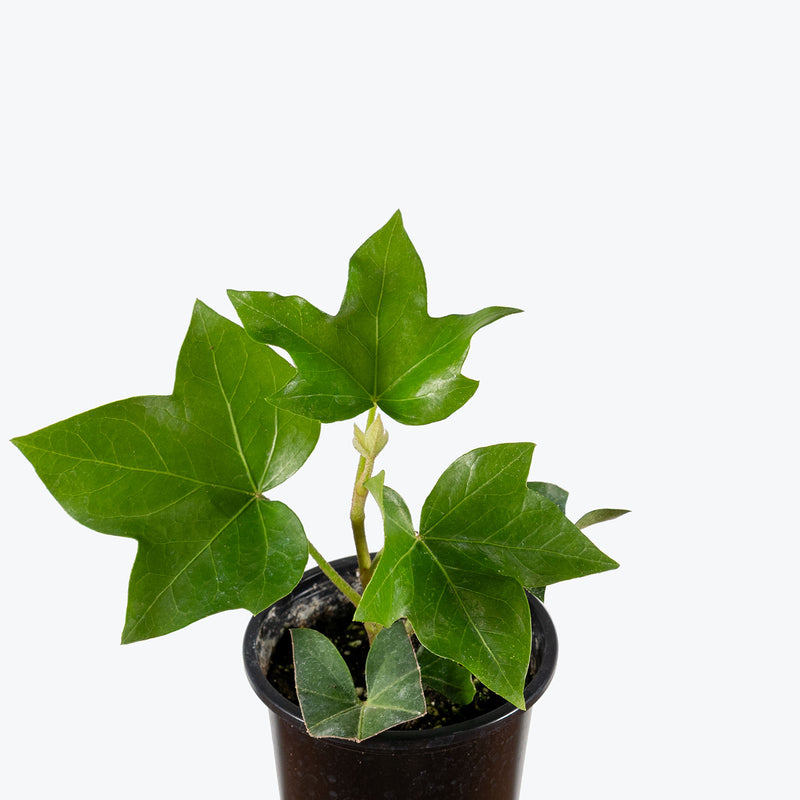
How to care for Fatshedera Lizei
Fatshedera Lizei should not be in a position to see the sun directly, although early morning or late evening sun is fine. Filtered sunlight through a sheer curtain is best and most homes are comprised primarily of indirect sunlight. The best spot for them is where they do not see the sun during the majority of the day but still get bright, indirect light.
Fatshedera Lizei will do well in medium light but will grow faster with brighter light. A good medium-light place in your home would be in the middle of a room that has a regular size window. Remember that plants will grow based on how much light they receive.
Fatshedera Lizei needs to be watered when the top half of the soil is dry to the touch. That usually takes about 1 week in an average home environment. It will vary depending on the time of year, your environment and lighting conditions, but it's always safer to underwater or give the soil a check before you water again. Expect to water more often in brighter light and less often in lower light.
Fatshedera Lizei can live in any average home humidity condition and are fairly hardy.
Train Fatshedera Lizei vertically on a trellis for a classic vine look or let it grow unsupported for a more shrub-like form. Prune occasionally to shape and encourage bushiness. Fatshedera Lizei prefers well-draining soil and benefits from monthly feeding during the growing season. Protect from frost if placed outdoors — it thrives in temperate zones or as a houseplant in colder climates.
Fatshedera Lizei is moderately toxic and can cause some adverse reactions when ingested, so it is best to not let your pets eat it, which we advise for all plants in general. The severity of the reaction will depend on how much of the plant is ingested but, if you know your pet typically does not eat your plants, this plant will be suitable for your home..
View PlantFatshedera Variegated Pia

How to care for Fatshedera Variegated Pia
Fatshedera Variegated Pia should not be in a position to see the sun directly, although early morning or late evening sun is fine. Filtered sunlight through a sheer curtain is best and most homes are comprised primarily of indirect sunlight. The best spot for them is where they do not see the sun during the majority of the day but still get bright, indirect light.
Fatshedera Variegated Pia will do well in medium light but will grow faster with brighter light. A good medium-light place in your home would be in the middle of a room that has a regular size window. Remember that plants will grow based on how much light they receive.
Fatshedera Variegated Pia needs to be watered when the top half of the soil is dry to the touch. That usually takes about 1 week in an average home environment. It will vary depending on the time of year, your environment and lighting conditions, but it's always safer to underwater or give the soil a check before you water again. Expect to water more often in brighter light and less often in lower light.
Fatshedera Variegated Pia can live in any average home humidity condition and are fairly hardy.
Fatshedera Variegated Pia is relatively easy to care for and is quite forgiving. However, it will benefit from occasional pruning to maintain its shape, and feeding with a balanced fertilizer during the growing season is recommended.
Fatshedera Variegated Pia is moderately toxic and can cause some adverse reactions when ingested so it is best to not let your pets eat it, which we advise for all plants in general. The severity of the reaction will depend on how much of the plant is ingested but, if you know your pet typically does not eat your plants, this plant will be suitable for your home..
View PlantFatsia Japonica

How to care for Fatsia Japonica
Fatsia Japonica should not be in a position to see the sun directly, although early morning or late evening sun is fine. Filtered sunlight through a sheer curtain is best and most homes are comprised primarily of indirect sunlight. The best spot for them is where they do not see the sun during the majority of the day but still get bright, indirect light.
Fatsia Japonica will thrive in medium to bright light, but also can tolerate low light. A good medium-light place in your home would be in the middle of a room that has a regular size window. They can be placed almost anywhere in the room but remember, plants will grow based on how much light they receive.
Fatsia Japonica needs to be watered when the top half of the soil is dry to the touch. That usually takes about 1 week in an average home environment. It will vary depending on the time of year, your environment and lighting conditions, but it's always safer to underwater or give the soil a check before you water again. Expect to water more often in brighter light and less often in lower light.
Fatsia Japonica can live in any average home humidity condition and are fairly hardy.
Fatsia Japonica benefits from regular dusting to keep its glossy leaves vibrant. Prune occasionally to shape or remove leggy growth. While it’s frost-tolerant outdoors in mild climates, indoor plants should be kept away from cold drafts and heat vents. Use a well-draining soil and fertilize monthly in the spring and summer to encourage steady growth.
You can feel comfortable having Fatsia Japonica around your home in the potential case where your pet feels like nibbling on it. However, we typically recommend keeping your pets from eating any of your houseplants..
View PlantFatsia Japonica Spider’s Web
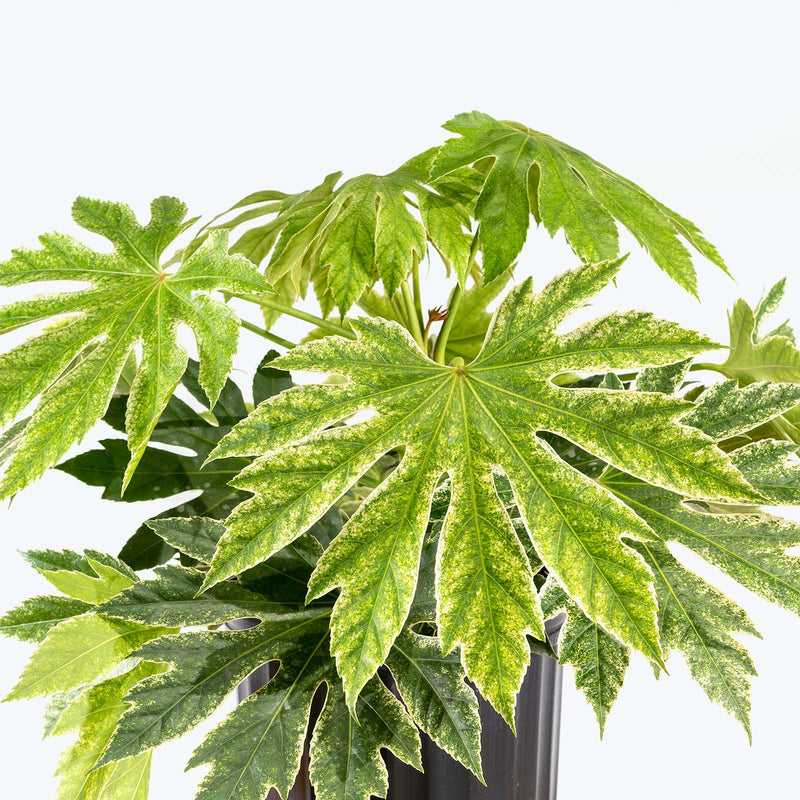
How to care for Fatsia Japonica Spider’s Web
They enjoy some direct sun, but they'll also do well in bright, indirect light. It is best to place this plant somewhere where it will receive some nice morning sun, or a couple hours of afternoon sun, avoiding prolonged sun exposure, and then indirect light the rest of the day.
They will do well in medium light but will grow faster with brighter light. A good medium-light place in your home would be in the middle of a room that has a regular size window. Remember that plants will grow based on how much light they receive.
They need to be watered when the top half of the soil is dry to the touch. That usually takes about 1 week in an average home environment. It will vary depending on the time of year, your environment and lighting conditions, but it's always safer to underwater or give the soil a check before you water again. Expect to water more often in brighter light and less often in lower light.
They will do well in average humidity environments but will appreciate a little bit of humidity if provided, give them a mist daily or get a humidifier.
Remember that plants with more variegation require brighter light than their green counterparts! Although they can handle medium light, their colouring will be stronger with brighter light.
You can feel comfortable having this plant around your home in the potential case where your pet feels like nibbling on it. However, we typically recommend keeping your pets from eating any of your houseplants..
Learn MoreView PlantFern Leaf Begonia
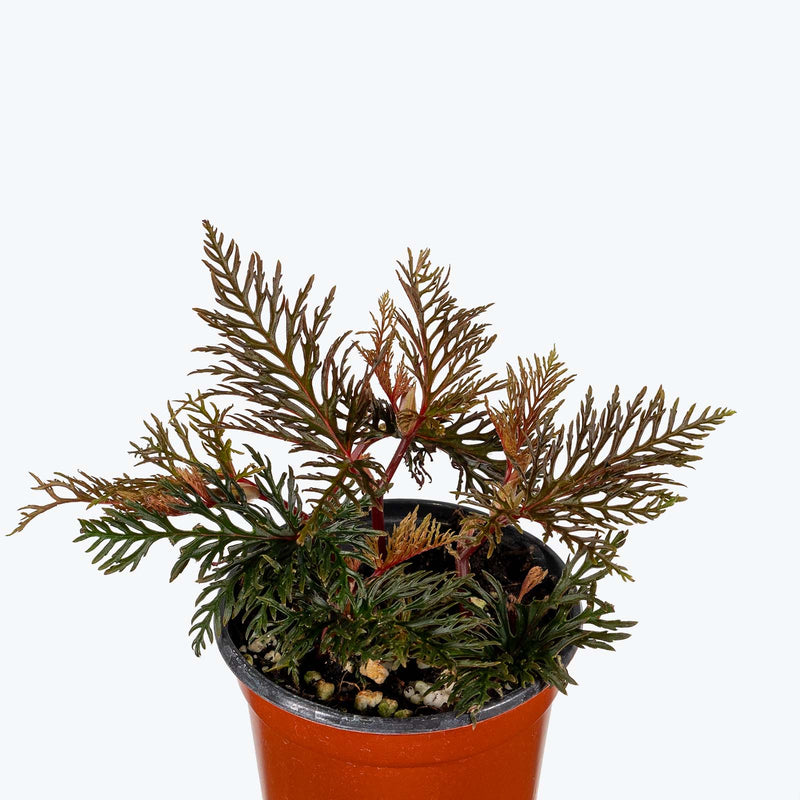
How to care for Fern Leaf Begonia
They should not be in a position to see the sun directly, although early morning or late evening sun is fine. Filtered sunlight through a sheer curtain is best and most homes are comprised primarily of indirect sunlight. The best spot for them is where they do not see the sun during the majority of the day but still get bright, indirect light.
They will do best in bright light. A nice bright place inside your home would be on the window sill or a stool that is right next to a window, either with or without blinds, depending on if the plant can handle sun. Remember that plants will grow based on how much light they receive.
Allow the top quarter of the soil to dry before watering again. This usually takes about 3 - 4 days in an average home environment. It will vary depending on the time of year, your environment and lighting conditions. Expect to water more often in brighter light and less often in lower light.
They like a high humidity environment, give them a mist daily or as often as possible. Alternatively, you can put them around a humidifier. Although they won't die if they don't receive enough humidity, their leaves may have some dry, crunchy, or yellow edges.
High humidity is key in keeping this plant happy and healthy, and it’s also relatively sensitive to too much handling and cold, too. A controlled environment like a terrarium is the best option, as it will meet the needs of not soggy but consistently moist soil, high humidity (70-90%), protection from sudden changes in temperature (12-26°C) and airflow to avoid powdery mildew and other fungal issues. Use room temperature water as cold water can damage the plant. Lastly, this plant is not a fan of direct sunlight but loves bright, indirect light from horticultural fluorescent lights. They require particularly bright light and are best positioned close to the centre of the light where light levels are most intense.
This plant is moderately toxic and can cause some adverse reactions when ingested so it is best to not let your pets eat it, which we advise for all plants in general. The severity of the reaction will depend on how much of the plant is ingested but, if you know your pet typically does not eat your plants, this plant will be suitable for your home..
View PlantFicus Alii
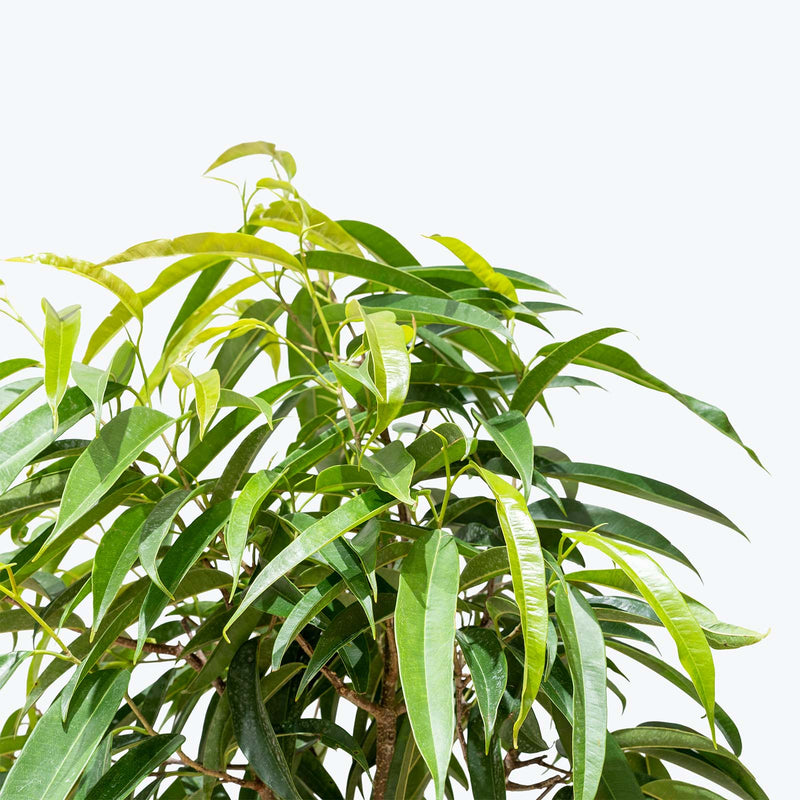
How to care for Ficus Alii
Ficus Alii should not be in a position to see the sun directly, although early morning or late evening sun is fine. Filtered sunlight through a sheer curtain is best and most homes are comprised primarily of indirect sunlight. The best spot for them is where they do not see the sun during the majority of the day but still get bright, indirect light.
Ficus Alii will thrive in bright light, but also can tolerate medium light. A good medium-light place in your home would be in the middle of a room that has a regular size window. They can be placed anywhere between the middle of the room and the window. Remember that plants will grow based on how much light they receive.
Ficus Alii needs to be watered when the top half of the soil is dry to the touch. That usually takes about 1 week in an average home environment. It will vary depending on the time of year, your environment and lighting conditions, but it's always safer to underwater or give the soil a check before you water again. Expect to water more often in brighter light and less often in lower light.
Ficus Alii will do well in average humidity environments but will appreciate a little bit of humidity if provided, give them a mist daily or get a humidifier.
Rotate Ficus Alii every few weeks to promote even growth and maintain its symmetrical form. Wipe the long leaves occasionally to remove dust and keep their glossy look. Use a well draining, loamy potting mix and fertilize monthly during spring and summer with a balanced, diluted fertilizer. Avoid sudden temperature or light changes, which may cause temporary leaf drops.
Ficus Alii is moderately toxic and can cause some adverse reactions when ingested so it is best to not let your pets eat it, which we advise for all plants in general. The severity of the reaction will depend on how much of the plant is ingested but, if you know your pet typically does not eat your plants, this plant will be suitable for your home..
View PlantFicus Altissima Yellow Gem
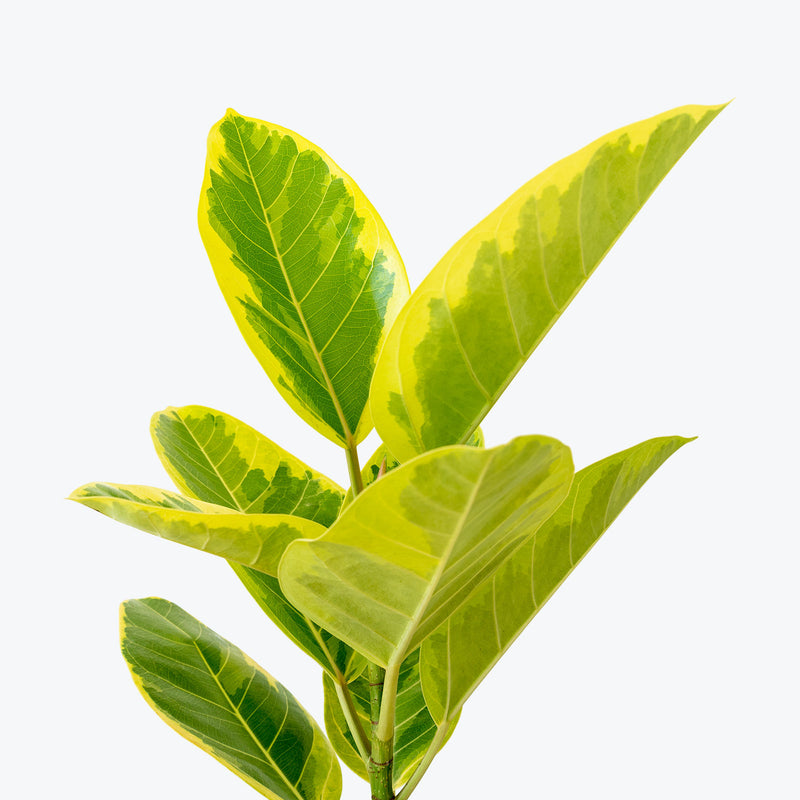
How to care for Ficus Altissima Yellow Gem
Ficus Altissima Yellow Gem enjoys some direct sun, but they'll also do well in bright, indirect light. It is best to place this plant somewhere where it will receive some nice morning sun, or a couple hours of afternoon sun, and then indirect light the rest of the day.
Ficus Altissima Yellow Gem will do best in bright light. A nice bright place inside your home would be on the window sill or a stool that is right next to a window, either with or without blinds, depending on if the plant can handle sun. Remember that plants will grow based on how much light they receive.
Ficus Altissima Yellow Gem likes the soil to be relatively dry before the next watering. That usually takes about 2 weeks in an average home environment. It will vary depending on the time of year, your environment and lighting conditions, but for them, it's always safer to underwater or water when you see signs of lack of water (i.e. droopy, floppy, or soft leaves). Water more often in the warmer months.
Ficus Altissima Yellow Gem can live in any average home humidity condition and are fairly hardy. Try to avoid letting water sit on their leaves for too long as this can lead to rot.
Ficus Altissima Yellow Gem is very sensitive to under watering and overwatering so make sure you are consistent in your care. Pay attention to abnormal signs like brown spots on the leaves, or leaves curling and falling off. Also ensure they are receiving adequate light. Water more frequently during warmer months and fertilize during growth.
Ficus Altissima Yellow Gem is moderately toxic and can cause some adverse reactions when ingested so it is best to not let your pets eat it, which we advise for all plants in general. The severity of the reaction will depend on how much of the plant is ingested but, if you know your pet typically does not eat your plants, this plant will be suitable for your home..
View PlantFicus Aspera Variegata
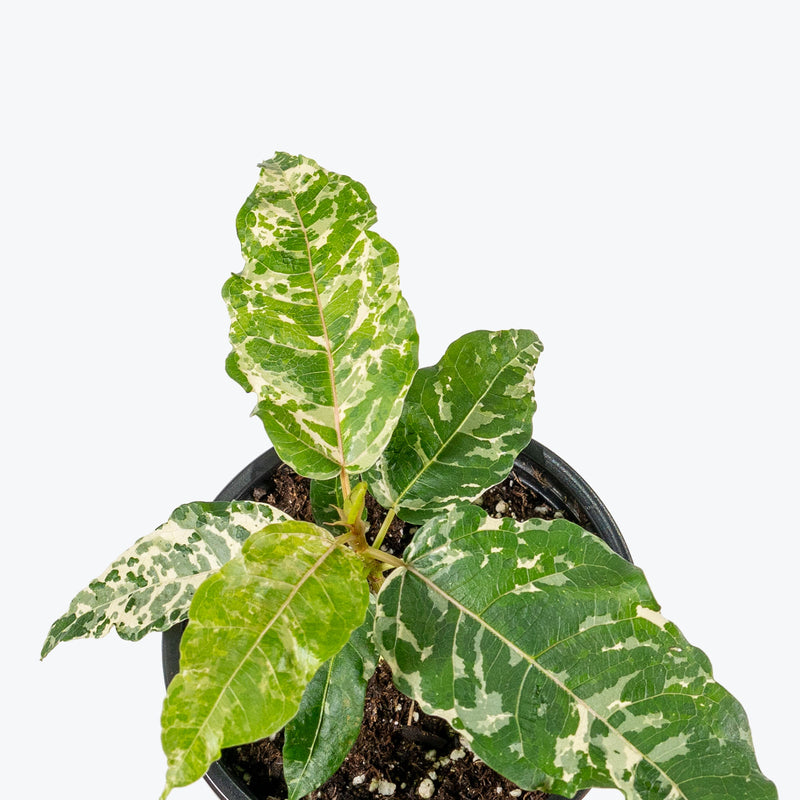
How to care for Ficus Aspera Variegata
Ficus Aspera Variegata should not be in a position to see the sun directly, although early morning or late evening sun is fine. Filtered sunlight through a sheer curtain is best and most homes are comprised primarily of indirect sunlight. The best spot for them is where they do not see the sun during the majority of the day but still get bright, indirect light.
Ficus Aspera Variegata will thrive in bright light, but also can tolerate medium light. A good medium-light place in your home would be in the middle of a room that has a regular size window. They can be placed anywhere between the middle of the room and the window. Remember that plants will grow based on how much light they receive.
Ficus Aspera Variegata needs to be watered when the top half of the soil is dry to the touch. That usually takes about 1 week in an average home environment. It will vary depending on the time of year, your environment and lighting conditions, but it's always safer to underwater or give the soil a check before you water again. Expect to water more often in brighter light and less often in lower light.
Ficus Aspera Variegata will do well in average humidity environments but will appreciate a little bit of humidity if provided, give them a mist daily or get a humidifier.
Fertilize your Ficus aspera 'Variegata' every 4-6 weeks during the growing season with a diluted, balanced liquid fertilizer. Pruning can help control its size and encourage fuller growth. Be mindful when handling, as the sap of Ficus plants can be irritating to the skin and toxic if ingested.
Ficus Aspera Variegata is moderately toxic and can cause some adverse reactions when ingested so it is best to not let your pets eat it, which we advise for all plants in general. The severity of the reaction will depend on how much of the plant is ingested but, if you know your pet typically does not eat your plants, this plant will be suitable for your home..
View PlantFicus Audrey
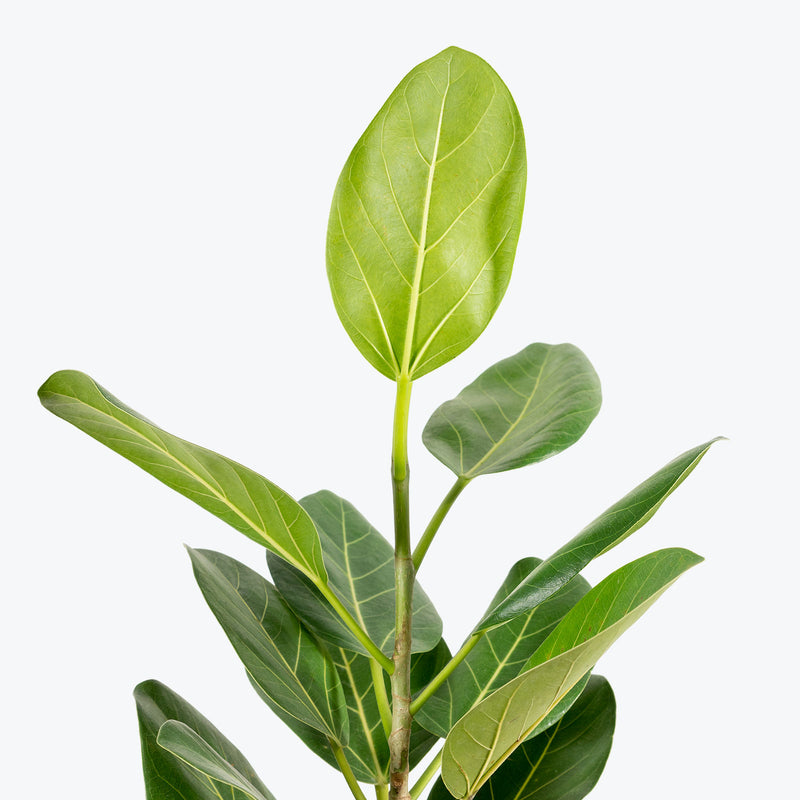
How to care for Ficus Audrey
Ficus Audrey enjoys some direct sun, but they'll also do well in bright, indirect light. It is best to place this plant somewhere where it will receive some nice morning sun, or a couple hours of afternoon sun, and then indirect light the rest of the day.
Ficus Audrey will do best in bright light. A nice bright place inside your home would be on the window sill or a stool that is right next to a window, either with or without blinds, depending on if the plant can handle sun. Remember that plants will grow based on how much light they receive.
Ficus Audrey needs to be watered when the top half of the soil is dry to the touch. That usually takes about 1 week in an average home environment. It will vary depending on the time of year, your environment and lighting conditions, but it's always safer to underwater or give the soil a check before you water again. Expect to water more often in brighter light and less often in lower light.
Ficus Audrey will do well in average humidity environments but will appreciate a little bit of humidity if provided, give them a mist daily or get a humidifier.
Ficus Audrey is happiest in a stable environment and should always be placed right in or near a window. Make environmental changes gradually and try not to move the plant in winter. Keep away from air conditioners, heaters and drafts.
Ficus Audrey is moderately toxic and can cause some adverse reactions when ingested so it is best to not let your pets eat it, which we advise for all plants in general. The severity of the reaction will depend on how much of the plant is ingested but, if you know your pet typically does not eat your plants, this plant will be suitable for your home..
View PlantFicus Audrey Golden
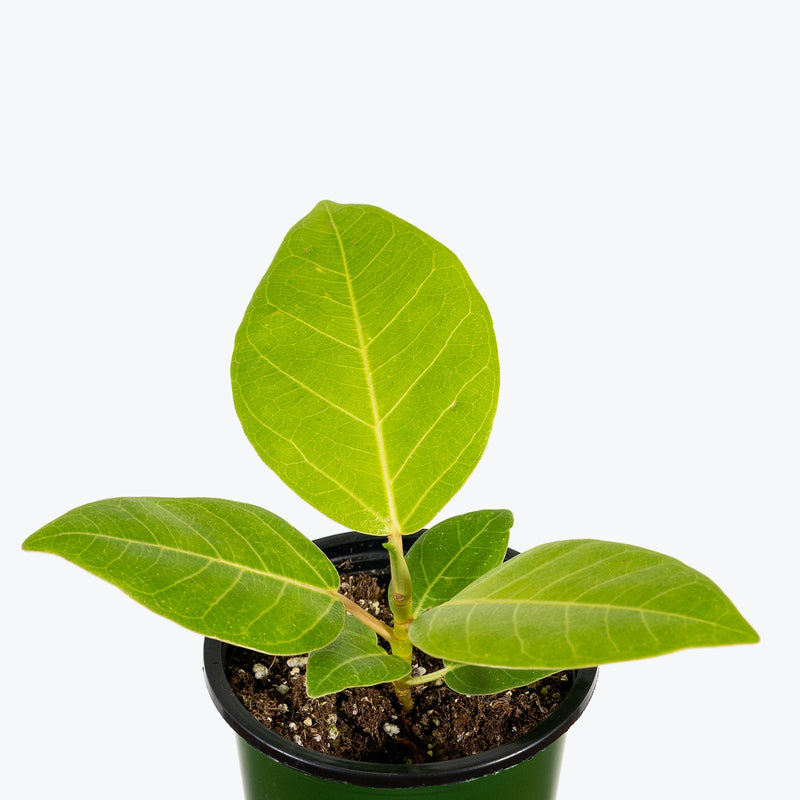
How to care for Ficus Audrey Golden
They enjoy some direct sun, but they'll also do well in bright, indirect light. It is best to place this plant somewhere where it will receive some nice morning sun, or a couple hours of afternoon sun, and then indirect light the rest of the day.
They will do best in bright light. A nice bright place inside your home would be on the window sill or a stool that is right next to a window, either with or without blinds, depending on if the plant can handle sun. Remember that plants will grow based on how much light they receive.
They need to be watered when the top half of the soil is dry to the touch. That usually takes about 1 week in an average home environment. It will vary depending on the time of year, your environment and lighting conditions, but it's always safer to underwater or give the soil a check before you water again. Expect to water more often in brighter light and less often in lower light.
They will do well in average humidity environments but will appreciate a little bit of humidity if provided, give them a mist daily or get a humidifier.
They are happiest in a stable environment and should always be placed right in or near a window. Make environmental changes gradually and try not to move the plant in winter. Keep away from air conditioners, heaters and drafts.
This plant is moderately toxic and can cause some adverse reactions when ingested so it is best to not let your pets eat it, which we advise for all plants in general. The severity of the reaction will depend on how much of the plant is ingested but, if you know your pet typically does not eat your plants, this plant will be suitable for your home..
View PlantFicus Benjamina Mini Lucie
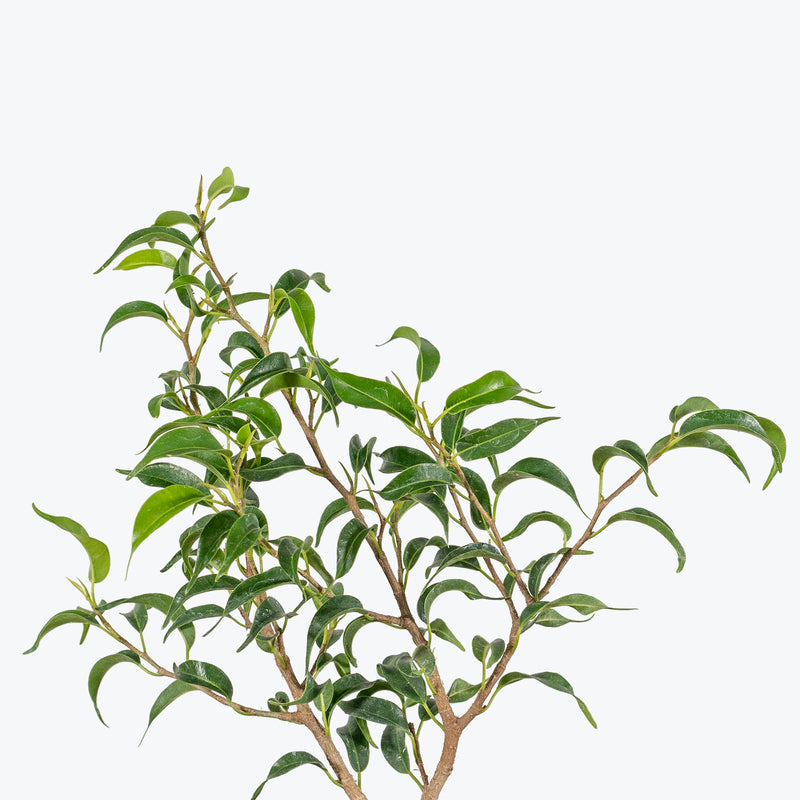
How to care for Ficus Benjamina Mini Lucie
They should not be in a position to see the sun directly, although early morning or late evening sun is fine. Filtered sunlight through a sheer curtain is best and most homes are comprised primarily of indirect sunlight. The best spot for them is where they do not see the sun during the majority of the day but still get bright, indirect light.
They will do best in bright light. A nice bright place inside your home would be on the window sill or a stool that is right next to a window, either with or without blinds, depending on if the plant can handle sun. Remember that plants will grow based on how much light they receive.
They need to be watered when the top half of the soil is dry to the touch. That usually takes about 1 week in an average home environment. It will vary depending on the time of year, your environment and lighting conditions, but it's always safer to underwater or give the soil a check before you water again. Expect to water more often in brighter light and less often in lower light.
They will do well in average humidity environments but will appreciate a little bit of humidity if provided, give them a mist daily or get a humidifier.
Make sure to give your plant plenty of bright, indirect light and not to move your plant around too much. If you need to make any environmental changes, make sure to do so gradually. When you bring your plant home, you can expect to lose a few leaves as your plant acclimates to your home.
This plant is moderately toxic and can cause some adverse reactions when ingested so it is best to not let your pets eat it, which we advise for all plants in general. The severity of the reaction will depend on how much of the plant is ingested but, if you know your pet typically does not eat your plants, this plant will be suitable for your home..
View PlantFicus Benjamina Neon
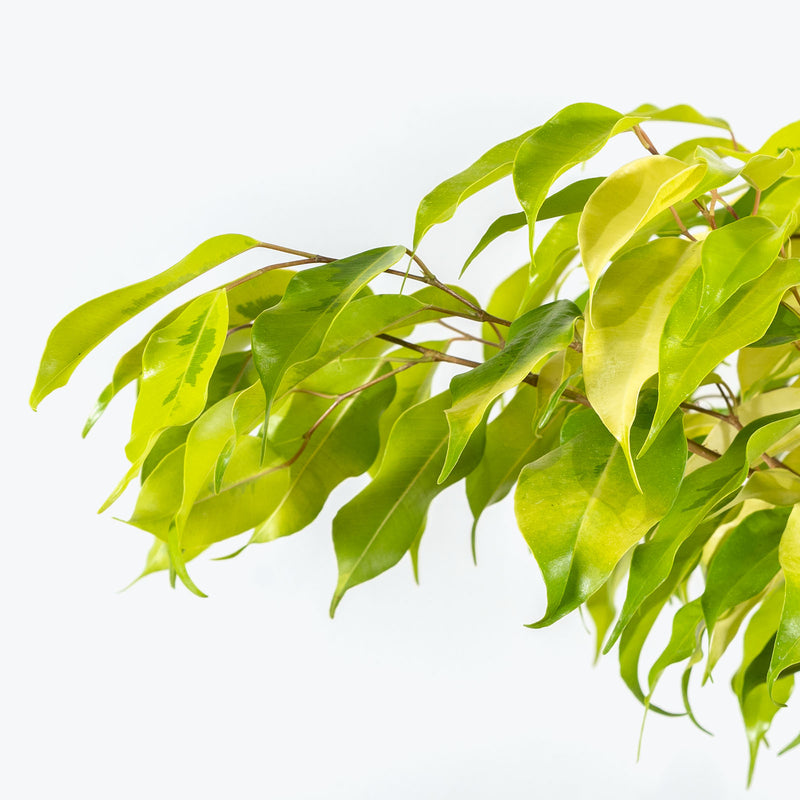
How to care for Ficus Benjamina Neon
They should not be in a position to see the sun directly, although early morning or late evening sun is fine. Filtered sunlight through a sheer curtain is best and most homes are comprised primarily of indirect sunlight. The best spot for them is where they do not see the sun during the majority of the day but still get bright, indirect light.
They will do best in bright light. A nice bright place inside your home would be on the window sill or a stool that is right next to a window, either with or without blinds, depending on if the plant can handle sun. Remember that plants will grow based on how much light they receive.
They need to be watered when the top half of the soil is dry to the touch. That usually takes about 1 week in an average home environment. It will vary depending on the time of year, your environment and lighting conditions, but it's always safer to underwater or give the soil a check before you water again. Expect to water more often in brighter light and less often in lower light.
They like a high humidity environment, give them a mist daily or as often as possible. Alternatively, you can put them around a humidifier. Although they won't die if they don't receive enough humidity, their leaves may have some dry, crunchy, or yellow edges.
They are prone to leaf drop so they will be their happiest in a stable environment and should always be placed right in or near a window. Make environmental changes gradually and try not to move the plant in winter. Keep away from air conditioners, heaters and drafts. Once acclimated to their new environment, they will flush out new leaves. Expect to water more often in the spring/summer months and less often in the Fall/Winter months.
This plant is moderately toxic and can cause some adverse reactions when ingested so it is best to not let your pets eat it, which we advise for all plants in general. The severity of the reaction will depend on how much of the plant is ingested but, if you know your pet typically does not eat your plants, this plant will be suitable for your home..
View PlantFicus Benjamina Starlight
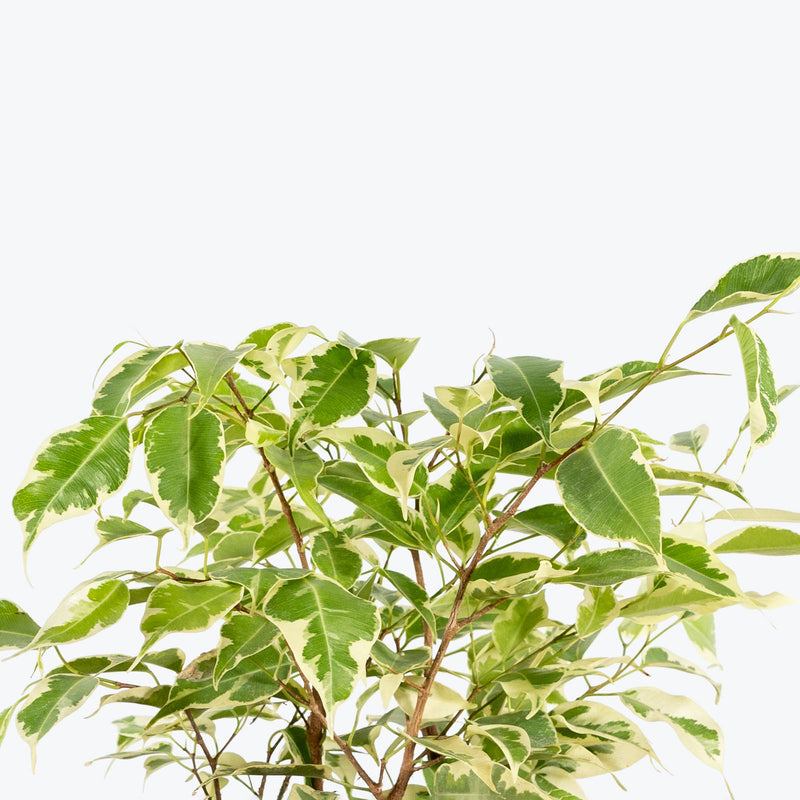
How to care for Ficus Benjamina Starlight
They should not be in a position to see the sun directly, although early morning or late evening sun is fine. Filtered sunlight through a sheer curtain is best and most homes are comprised primarily of indirect sunlight. The best spot for them is where they do not see the sun during the majority of the day but still get bright, indirect light.
They will do best in bright light. A nice bright place inside your home would be on the window sill or a stool that is right next to a window, either with or without blinds, depending on if the plant can handle sun. Remember that plants will grow based on how much light they receive.
They need to be watered when the top half of the soil is dry to the touch. That usually takes about 1 week in an average home environment. It will vary depending on the time of year, your environment and lighting conditions, but it's always safer to underwater or give the soil a check before you water again.
They will do well in average humidity environments but will appreciate a little bit of humidity if provided, give them a mist daily or get a humidifier.
Ficus do not like to be moved around a lot. A sudden change in location often causes the leaves to shed, although they will grow back in time in their new environment. Therefore, make environmental changes gradually and try not to move the plant in winter. Keep away from air conditioners, heaters and drafts. They are also very sensitive to under watering and overwatering so make sure you are consistent in your care.
This plant is moderately toxic and can cause some adverse reactions when ingested so it is best to not let your pets eat it, which we advise for all plants in general. The severity of the reaction will depend on how much of the plant is ingested but, if you know your pet typically does not eat your plants, this plant will be suitable for your home..
View PlantFicus Benjamina Wintergreen
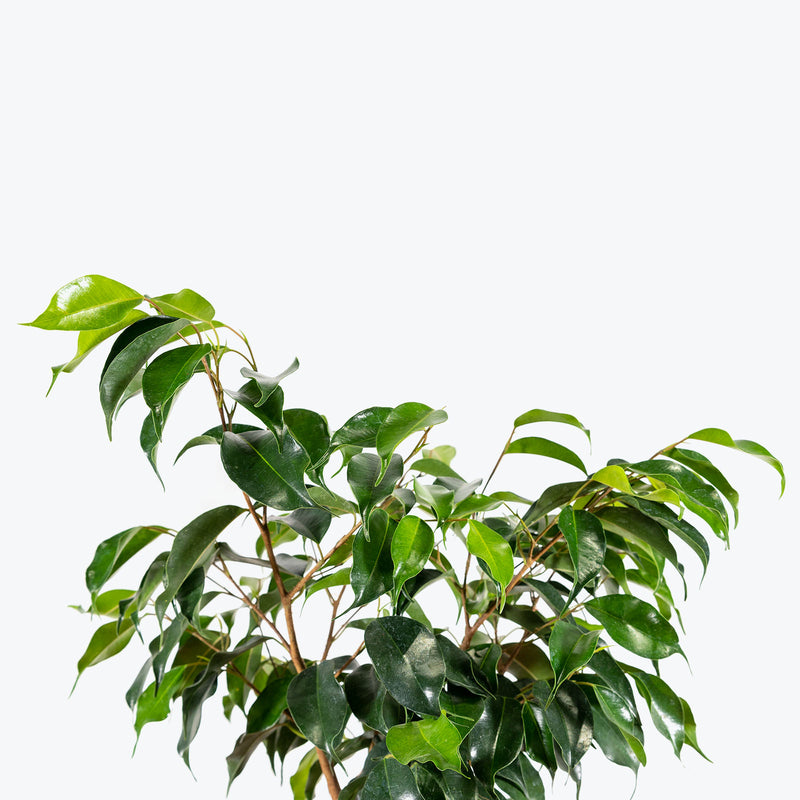
How to care for Ficus Benjamina Wintergreen
They should not be in a position to see the sun directly, although early morning or late evening sun is fine. Filtered sunlight through a sheer curtain is best and most homes are comprised primarily of indirect sunlight. The best spot for them is where they do not see the sun during the majority of the day but still get bright, indirect light.
They will do best in bright light. A nice bright place inside your home would be on the window sill or a stool that is right next to a window, either with or without blinds, depending on if the plant can handle sun. Remember that plants will grow based on how much light they receive.
They need to be watered when the top half of the soil is dry to the touch. That usually takes about 1 week in an average home environment. It will vary depending on the time of year, your environment and lighting conditions, but it's always safer to underwater or give the soil a check before you water again. Expect to water more often in brighter light and less often in lower light.
They like a high humidity environment, give them a mist daily or as often as possible. Alternatively, you can put them around a humidifier. Although they won't die if they don't receive enough humidity, their leaves may have some dry, crunchy, or yellow edges.
They are prone to leaf drop so they will be their happiest in a stable environment and should always be placed right in or near a window. Make environmental changes gradually and try not to move the plant in winter. Keep away from air conditioners, heaters and drafts. Once acclimated to their new environment, they will flush out new leaves. Expect to water more often in the spring/summer months and less often in the Fall/Winter months.
This plant is moderately toxic and can cause some adverse reactions when ingested so it is best to not let your pets eat it, which we advise for all plants in general. The severity of the reaction will depend on how much of the plant is ingested but, if you know your pet typically does not eat your plants, this plant will be suitable for your home..
View PlantFicus Diversifolia

How to care for Ficus Diversifolia
Ficus Diversifolia enjoys some direct sun, but they'll also do well in bright, indirect light. It is best to place this plant somewhere where it will receive some nice morning sun, or a couple hours of afternoon sun, and then indirect light the rest of the day.
Ficus Diversifolia will do best in bright light. A nice bright place inside your home would be on the window sill or a stool that is right next to a window, either with or without blinds, depending on if the plant can handle sun. Remember that plants will grow based on how much light they receive.
Ficus Diversifolia needs to be watered when the top half of the soil is dry to the touch. That usually takes about 1 week in an average home environment. It will vary depending on the time of year, your environment and lighting conditions, but it's always safer to underwater or give the soil a check before you water again. Expect to water more often in brighter light and less often in lower light.
Ficus Diversifolia will do well in average humidity environments but will appreciate a little bit of humidity if provided, give them a mist daily or get a humidifier.
Once established in the right position, avoid moving your Ficus Diversifolia too often as this will cause stress and leaf loss. Therefore, environmental changes should be made gradually, and they should not be moved in winter. Keep away from air conditioners, heaters and drafts. They are also very sensitive to under-watering and overwatering so make sure you are consistent in your care.
Ficus Diversifolia is moderately toxic and can cause some adverse reactions when ingested so it is best to not let your pets eat it, which we advise for all plants in general. The severity of the reaction will depend on how much of the plant is ingested but, if you know your pet typically does not eat your plants, this plant will be suitable for your home..
View PlantFicus El Dorado
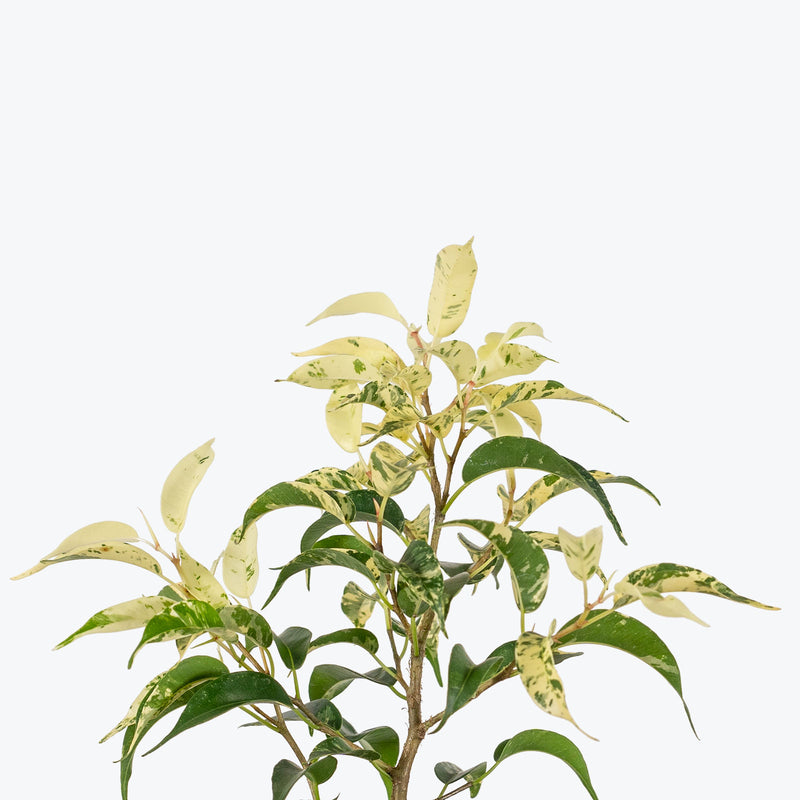
How to care for Ficus El Dorado
Ficus El Dorado should not be in a position to see the sun directly, although early morning or late evening sun is fine. Filtered sunlight through a sheer curtain is best and most homes are comprised primarily of indirect sunlight. The best spot for them is where they do not see the sun during the majority of the day but still get bright, indirect light.
Ficus El Dorado will do best in bright light. A nice bright place inside your home would be on the window sill or a stool that is right next to a window, either with or without blinds, depending on if the plant can handle sun. Remember that plants will grow based on how much light they receive.
Ficus El Dorado needs to be watered when the top half of the soil is dry to the touch. That usually takes about 1 week in an average home environment. It will vary depending on the time of year, your environment and lighting conditions, but it's always safer to underwater or give the soil a check before you water again. Expect to water more often in brighter light and less often in lower light.
Ficus El Dorado will do well in average humidity environments but will appreciate a little bit of humidity if provided, give them a mist daily or get a humidifier.
Make sure to give Ficus El Dorado plenty of bright, indirect light and not to move your plant around too much. If you need to make any environmental changes, make sure to do so gradually. When you bring your plant home, you can expect to lose a few leaves as your plant acclimates to your home.
Ficus El Dorado is moderately toxic and can cause some adverse reactions when ingested so it is best to not let your pets eat it, which we advise for all plants in general. The severity of the reaction will depend on how much of the plant is ingested but, if you know your pet typically does not eat your plants, this plant will be suitable for your home..
View PlantFicus Ginseng Bonsai
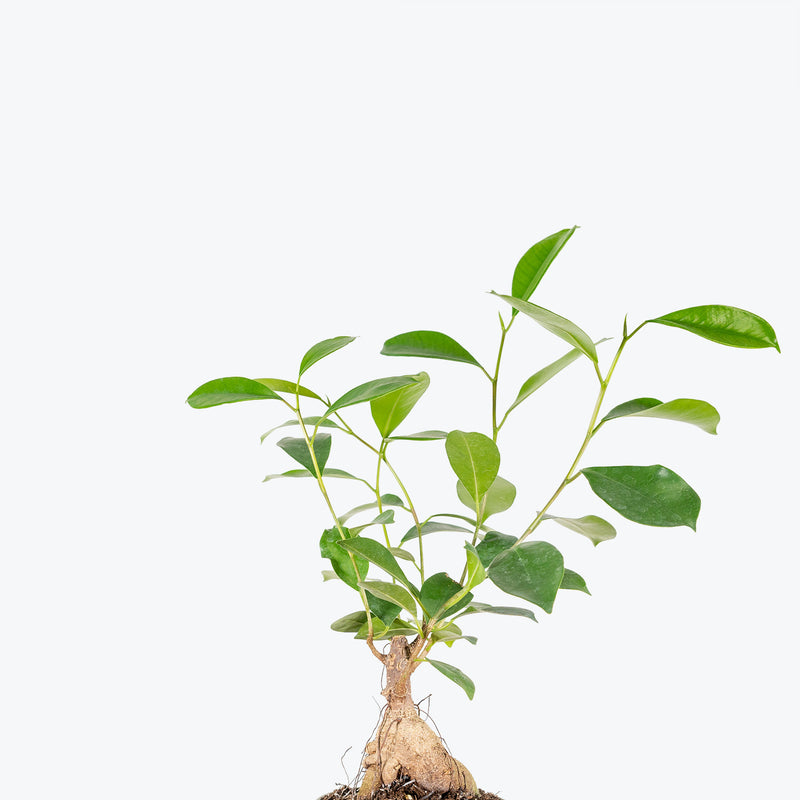
How to care for Ficus Ginseng Bonsai
Ficus Ginseng Bonsai should not be in a position to see the sun directly, although early morning or late evening sun is fine. Filtered sunlight through a sheer curtain is best and most homes are comprised primarily of indirect sunlight. The best spot for them is where they do not see the sun during the majority of the day but still get bright, indirect light.
Ficus Ginseng Bonsai will do best in bright light. A nice bright place inside your home would be on the window sill or a stool that is right next to a window, either with or without blinds, depending on if the plant can handle sun. Remember that plants will grow based on how much light they receive.
Ficus Ginseng Bonsai likes the soil to be relatively dry before the next watering. That usually takes about 2 weeks in an average home environment. It will vary depending on the time of year, your environment and lighting conditions, but for them, it's always safer to underwater or water when you see signs of lack of water (i.e. droopy, floppy, or soft leaves). Water more often in the warmer months!
Ficus Ginseng Bonsai likes a high humidity environment, give them a mist daily or as often as possible. Alternatively, you can put them around a humidifier. Although they won't die if they don't receive enough humidity, their leaves may have some dry, crunchy, or yellow edges.
Ficus Ginseng Bonsai attracts insects, keep an eye on them and check the stems and leaves often, remove any pests if seen to avoid spreading. Growing it in moist and warm environments will trigger aerial roots which make for a great addition to a plant pot composition.
Ficus Ginseng Bonsai is moderately toxic and can cause some adverse reactions when ingested so it is best to not let your pets eat it, which we advise for all plants in general. The severity of the reaction will depend on how much of the plant is ingested but, if you know your pet typically does not eat your plants, this plant will be suitable for your home..
View PlantFicus Moclame
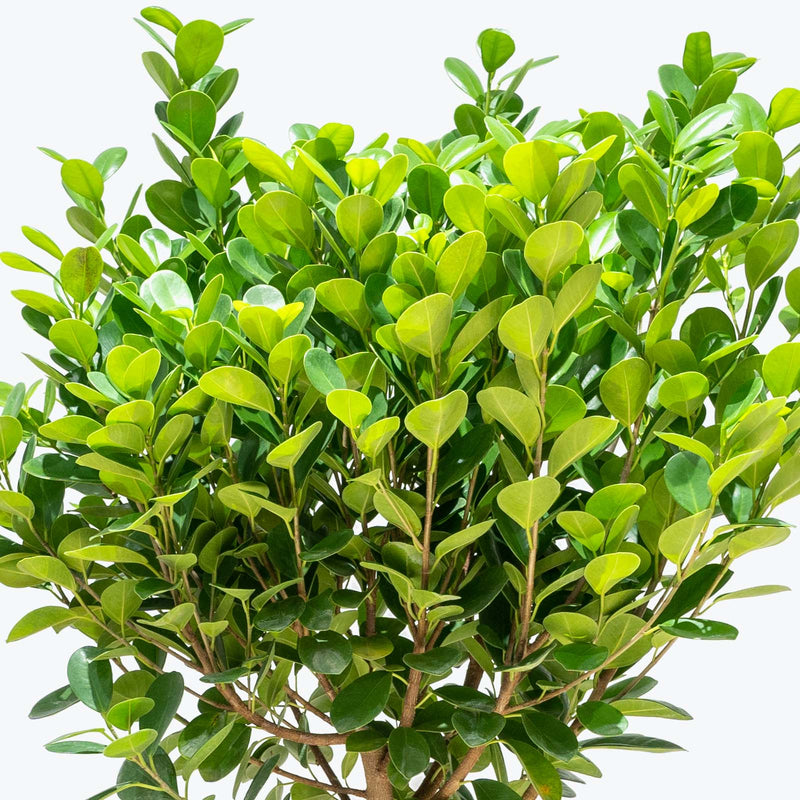
How to care for Ficus Moclame
Ficus Moclame enjoys some direct sun, but they'll also do well in bright, indirect light. It is best to place this plant somewhere where it will receive some nice morning sun, or a couple hours of afternoon sun, and then indirect light the rest of the day.
Ficus Moclame will do best in bright light. A nice bright place inside your home would be on the window sill or a stool that is right next to a window, either with or without blinds, depending on if the plant can handle sun. Remember that plants will grow based on how much light they receive.
Ficus Moclame needs to be watered when the top half of the soil is dry to the touch. That usually takes about 1 week in an average home environment. It will vary depending on the time of year, your environment and lighting conditions, but it's always safer to underwater or give the soil a check before you water again. Expect to water more often in brighter light and less often in lower light.
Ficus Moclame likes a high humidity environment, give them a mist daily or as often as possible. Alternatively, you can put them around a humidifier. Although they won't die if they don't receive enough humidity, their leaves may have some dry, crunchy, or yellow edges. Avoid keeping them near any drafts (i.e. open doors during the winter, heating vents, AC, etc.)
As with most Ficus, Ficus Moclame can be sensitive to environmental shock. It is normal to see some leaf loss in the first week or two of receiving your plant, but if leaf loss and discolouration are excessive or persist, assess the water and light requirements.
Ficus Moclame is moderately toxic and can cause some adverse reactions when ingested so it is best to not let your pets eat it, which we advise for all plants in general. The severity of the reaction will depend on how much of the plant is ingested but, if you know your pet typically does not eat your plants, this plant will be suitable for your home..
View PlantFicus Pumila
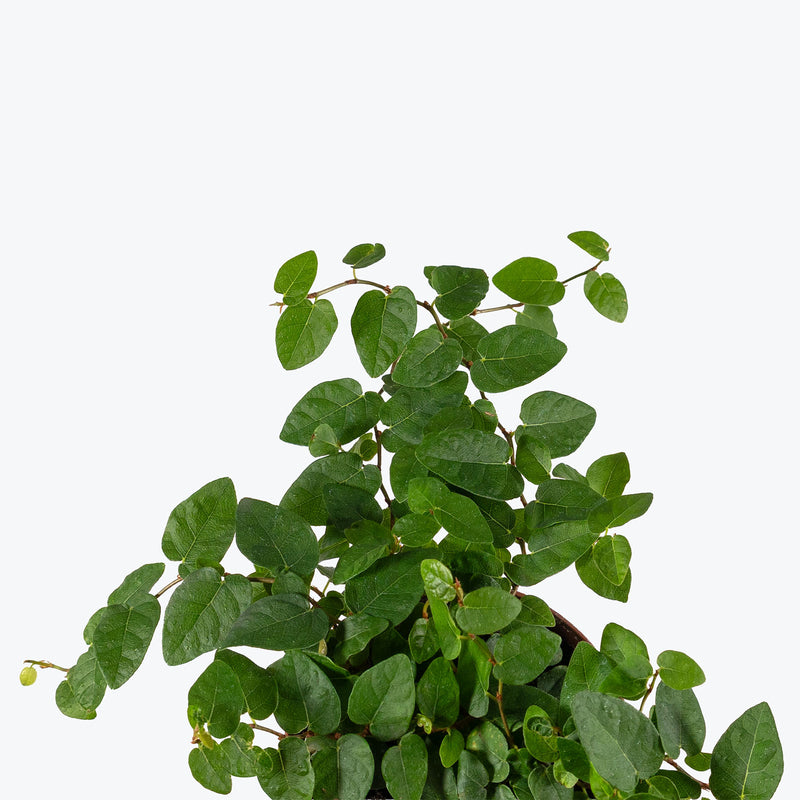
How to care for Ficus Pumila
Ficus Pumila should not be in a position to see the sun directly, although early morning or late evening sun is fine. Filtered sunlight through a sheer curtain is best and most homes are comprised primarily of indirect sunlight. The best spot for them is where they do not see the sun during the majority of the day but still get bright, indirect light.
Ficus Pumila will thrive in bright light, but also can tolerate medium light. A good medium-light place in your home would be in the middle of a room that has a regular size window. They can be placed anywhere between the middle of the room and the window. Remember that plants will grow based on how much light they receive.
Allow the top quarter of the soil to dry before watering Ficus Pumila again. This usually takes about 3 - 4 days in an average home environment. It will vary depending on the time of year, your environment and lighting conditions. Expect to water more often in brighter light and less often in lower light.
Ficus Pumila will do well in average humidity environments but will appreciate a little bit of humidity if provided, give them a mist daily or get a humidifier.
Ficus Pumila grows quickly and may need pruning to keep it tidy indoors. Outdoors in tropical climates, it can spread aggressively, so container growth is often best for easy control. It can also be trained on moss poles, trellises, or walls for a climbing effect.
Ficus Pumila is moderately toxic and can cause some adverse reactions when ingested, so it is best to not let your pets eat it, which we advise for all plants in general. The severity of the reaction will depend on how much of the plant is ingested but, if you know your pet typically does not eat your plants, this plant will be suitable for your home..
View PlantFicus Pumila Quercifolia
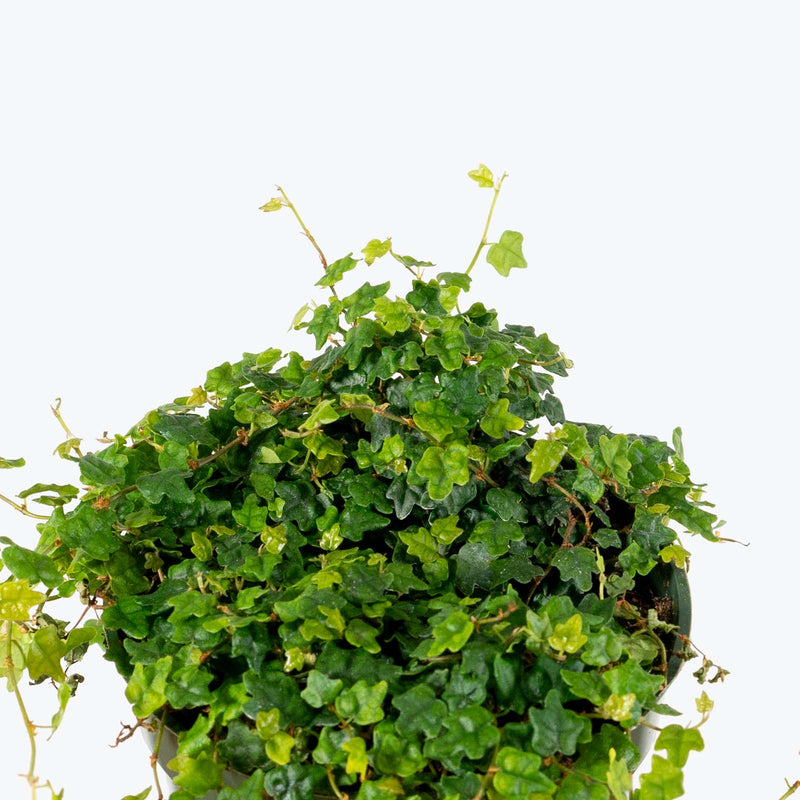
How to care for Ficus Pumila Quercifolia
Ficus Pumila Quercifolia should not be in a position to see the sun directly, although early morning or late evening sun is fine. Filtered sunlight through a sheer curtain is best and most homes are comprised primarily of indirect sunlight. The best spot for them is where they do not see the sun during the majority of the day but still get bright, indirect light.
Ficus Pumila Quercifolia will thrive in bright light, but also can tolerate medium light. A good medium-light place in your home would be in the middle of a room that has a regular size window. They can be placed anywhere between the middle of the room and the window. Remember that plants will grow based on how much light they receive.
Allow the top quarter of the soil to dry before watering again. This usually takes about 3 - 4 days in an average home environment. It will vary depending on the time of year, your environment and lighting conditions. Expect to water more often in brighter light and less often in lower light.
Ficus Pumila Quercifolia will do well in average humidity environments but will appreciate a little bit of humidity if provided, give them a mist daily or get a humidifier.
Feed Ficus Pumila Quercifolia every 4-6 weeks during the growing season with a diluted, balanced fertilizer. Pruning is not typically necessary but can be done to shape the plant or control its growth. Given its vining habit, providing a trellis or support can encourage vertical growth if desired.
Ficus Pumila Quercifolia is moderately toxic and can cause some adverse reactions when ingested so it is best to not let your pets eat it, which we advise for all plants in general. The severity of the reaction will depend on how much of the plant is ingested but, if you know your pet typically does not eat your plants, this plant will be suitable for your home..
View PlantFicus Pumila Variegata
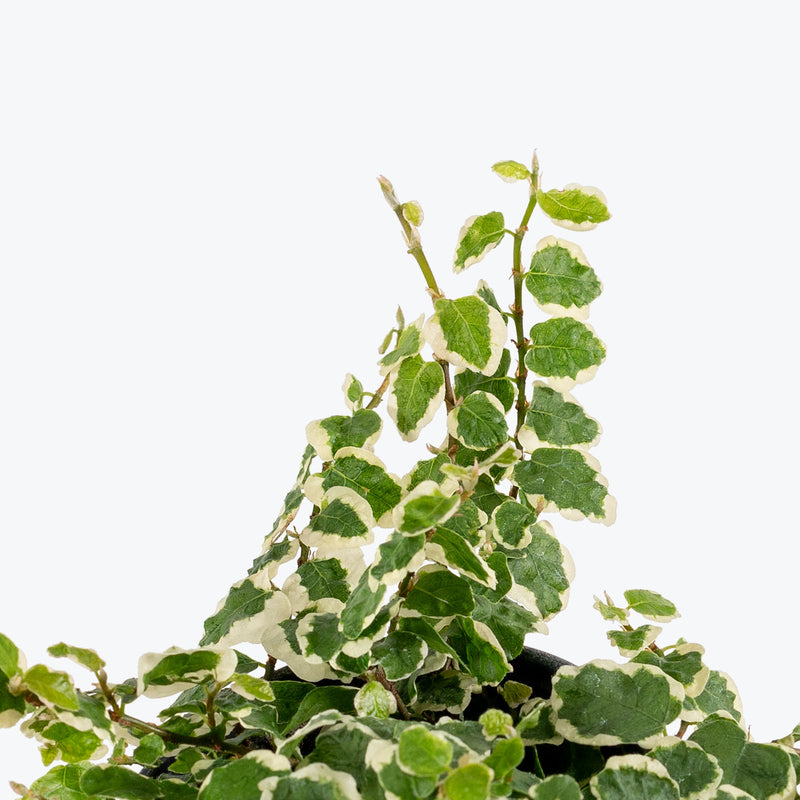
How to care for Ficus Pumila Variegata
Ficus Pumila Variegata should not be in a position to see the sun directly, although early morning or late evening sun is fine. Filtered sunlight through a sheer curtain is best and most homes are comprised primarily of indirect sunlight. The best spot for them is where they do not see the sun during the majority of the day but still get bright, indirect light.
Ficus Pumila Variegata will thrive in bright light, but also can tolerate medium light. A good medium-light place in your home would be in the middle of a room that has a regular size window. They can be placed anywhere between the middle of the room and the window. Remember that plants will grow based on how much light they receive.
Allow the top quarter of the soil to dry before watering again. This usually takes about 3 - 4 days in an average home environment. It will vary depending on the time of year, your environment and lighting conditions. Expect to water more often in brighter light and less often in lower light.
Ficus Pumila Variegata will do well in average humidity environments but will appreciate a little bit of humidity if provided, give them a mist daily or get a humidifier.
Prune Ficus Pumila Variegata regularly to maintain the desired shape and size, especially if you are growing it as an indoor plant. This will also encourage fuller growth.
Ficus Pumila Variegata is moderately toxic and can cause some adverse reactions when ingested so it is best to not let your pets eat it, which we advise for all plants in general. The severity of the reaction will depend on how much of the plant is ingested but, if you know your pet typically does not eat your plants, this plant will be suitable for your home..
View PlantFicus Retusa Bonsai
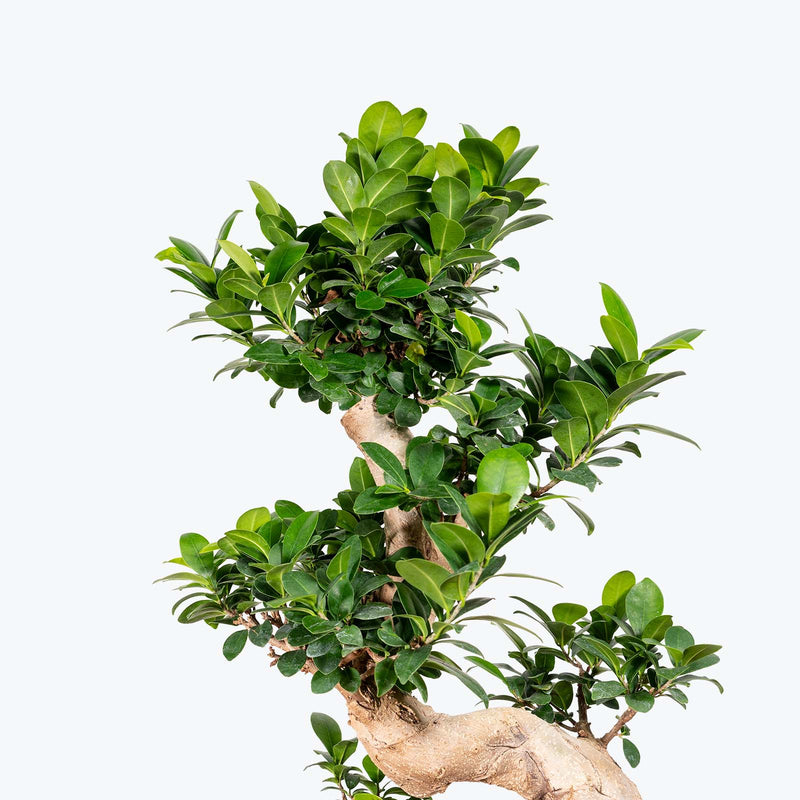
How to care for Ficus Retusa Bonsai
They should not be in a position to see the sun directly, although early morning or late evening sun is fine. Filtered sunlight through a sheer curtain is best and most homes are comprised primarily of indirect sunlight. The best spot for them is where they do not see the sun during the majority of the day but still get bright, indirect light.
They will do best in bright light. A nice bright place inside your home would be on the window sill or a stool that is right next to a window, either with or without blinds, depending on if the plant can handle sun. Remember that plants will grow based on how much light they receive.
They need to be watered when the top half of the soil is dry to the touch. That usually takes about 1 week in an average home environment. It will vary depending on the time of year, your environment and lighting conditions, but it's always safer to underwater or give the soil a check before you water again. Expect to water more often in brighter light and less often in lower light.
They like a high humidity environment, give them a mist daily or as often as possible. Alternatively, you can put them around a humidifier. Although they won't die if they don't receive enough humidity, their leaves may have some dry, crunchy, or yellow edges.
Ficus Retusa Bonsai, with its distinctive S-shape, requires a balanced care routine to maintain its sculpted form and health. Regular pruning is essential to manage its shape and promote denser foliage.
This plant is moderately toxic and can cause some adverse reactions when ingested so it is best to not let your pets eat it, which we advise for all plants in general. The severity of the reaction will depend on how much of the plant is ingested but, if you know your pet typically does not eat your plants, this plant will be suitable for your home..
View PlantFicus Shivereana Moonshine
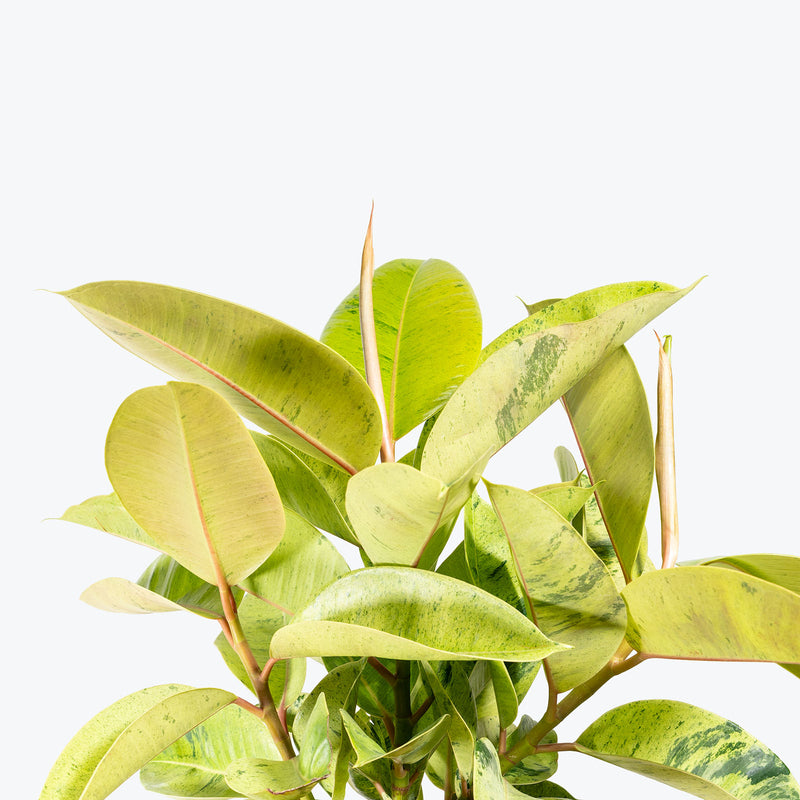
How to care for Ficus Shivereana Moonshine
Ficus Shivereana Moonshine should not be in a position to the see the sun directly, as it is too intense for them. Filtered sunlight through a sheer curtain is fine and most homes are comprised primarily of indirect sunlight. The best spot for them is where they do not see the sun during the majority of the day but still get bright, indirect light.
Ficus Shivereana Moonshine will do best in bright light. A nice bright place inside your home would be on the window sill or a stool that is right next to a window, either with or without blinds, depending on if the plant can handle sun. Remember that plants will grow based on how much light they receive.
Ficus Shivereana Moonshine likes the soil to be relatively dry before the next watering. That usually takes about two weeks in an average home environment. It may vary depending on the time of year, your environment and lighting conditions, but for them, it's always safer to under water or water when you see signs of lack of water (i.e. droopy, floppy, or soft leaves). Water more often in the warmer months!
Ficus Shivereana Moonshine can live in any average home humidity condition and is fairly hardy. Try to avoid letting water sit on their leaves for too long as this can lead to rot.
Ficus Shivereana Moonshine likes consistency, so avoid repotting, moving, or otherwise disturbing the plant if possible. Once established, it will reward you with rapid and consistent growth.
Ficus Shivereana Moonshine is moderately toxic and can cause some adverse reactions when ingested so it is best to not let your pets eat it, which we advise for all plants in general. The severity of the reaction will depend on how much of the plant is ingested but, if you know your pet typically does not eat your plants, this plant will be suitable for your home..
View PlantFicus Triangularis Variegata
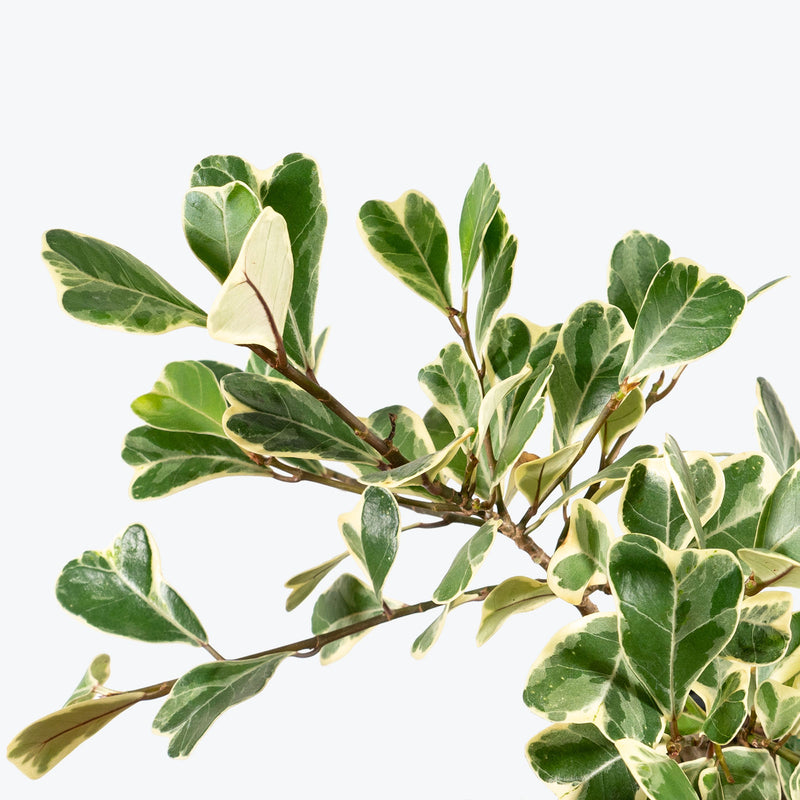
How to care for Ficus Triangularis Variegata
They should not be in a position to see the sun directly, although early morning or late evening sun is fine. Filtered sunlight through a sheer curtain is best and most homes are comprised primarily of indirect sunlight. The best spot for them is where they do not see the sun during the majority of the day but still get bright, indirect light.
They will do best in bright light. A nice bright place inside your home would be on the window sill or a stool that is right next to a window, either with or without blinds, depending on if the plant can handle sun. Remember that plants will grow based on how much light they receive.
They like the soil to be relatively dry before the next watering. That usually takes about 2 weeks in an average home environment. It will vary depending on the time of year, your environment and lighting conditions, but for them, it's always safer to underwater or water when you see signs of lack of water (i.e. droopy, floppy, or soft leaves). Expect to water more often in brighter light and less often in lower light.
They will do well in average humidity environments but will appreciate a little bit of humidity if provided, give them a mist daily or get a humidifier!
Dropping leaves usually means not enough water, red spots on the undersides of leaves usually mean too much sunlight. Ficus do not like to be moved around a lot. A sudden change in location often causes the leaves to shed, although they will grow back in time in their new environment. Therefore, make environmental changes gradually and try not to move the plant in winter. Keep away from air conditioners, heaters and drafts. They are also very sensitive to under watering and overwatering so make sure you are consistent in your care.
This plant is moderately toxic and can cause some adverse reactions when ingested so it is best to not let your pets eat it, which we advise for all plants in general. The severity of the reaction will depend on how much of the plant is ingested but, if you know your pet typically does not eat your plants, this plant will be suitable for your home..
View PlantFicus Umbellata
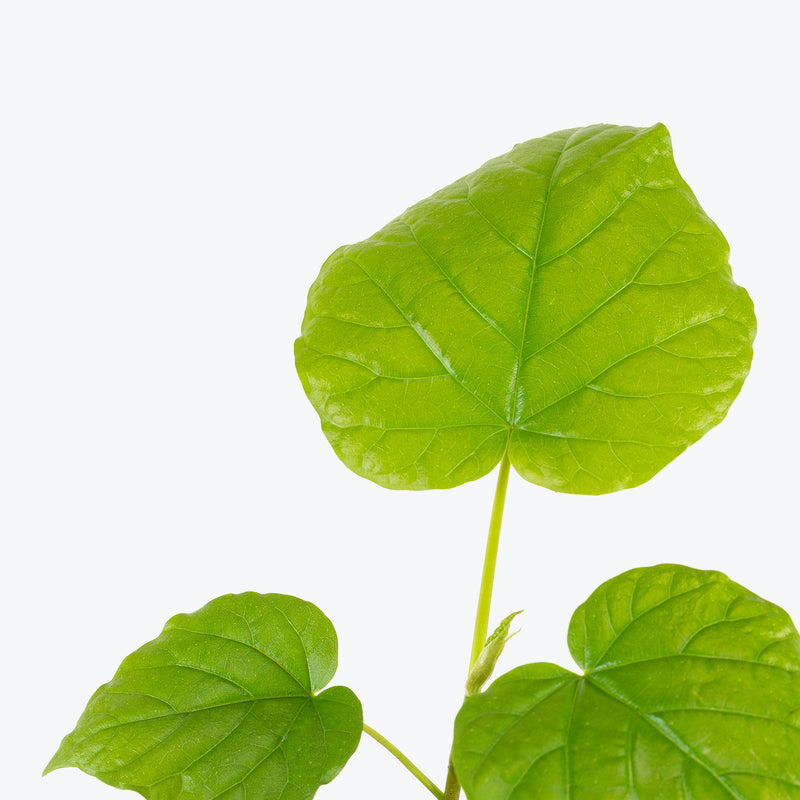
How to care for Ficus Umbellata
They enjoy some direct sun, but they'll also do well in bright, indirect light. It is best to place this plant somewhere where it will receive some nice morning sun, or a couple hours of afternoon sun, and then indirect light the rest of the day.
They will do best in bright light. A nice bright place inside your home would be on the window sill or a stool that is right next to a window, either with or without blinds, depending on if the plant can handle sun. Remember that plants will grow based on how much light they receive.
They need to be watered when the top half of the soil is dry to the touch. That usually takes about 1 week in an average home environment. It will vary depending on the time of year, your environment and lighting conditions, but it's always safer to look for a slight droop in the leaves or give the soil a check before you water again. Expect to water more often in brighter light and less often in lower light.
They can live in any average home humidity condition and are fairly hardy.
These beauties are happiest in a stable environment and should always be placed right in or near a window. If you decide to keep your plant in the direct morning sunlight, make environmental changes gradually, allowing it to acclimatize, and try not to move the plant in winter. Keep away from air conditioners, heaters and drafts.
This plant is moderately toxic and can cause some adverse reactions when ingested so it is best to not let your pets eat it, which we advise for all plants in general. The severity of the reaction will depend on how much of the plant is ingested but, if you know your pet typically does not eat your plants, this plant will be suitable for your home..
View PlantFiddle Leaf Fig Bambino
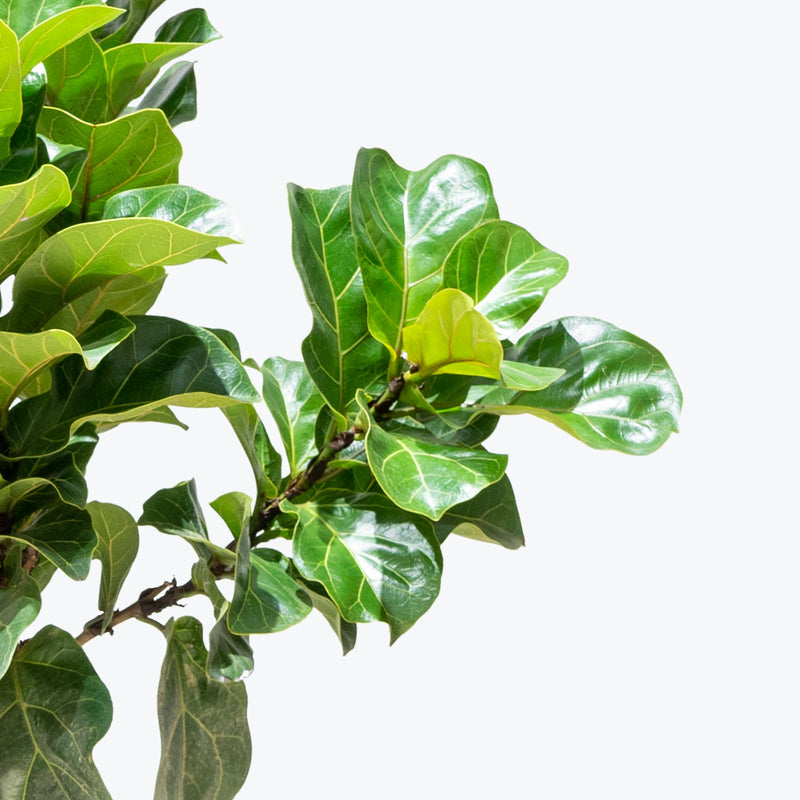
How to care for Fiddle Leaf Fig Bambino
Fiddle Leaf Fig Bambino enjoys some direct sun, but they'll also do well in bright, indirect light. It is best to place this plant somewhere where it will receive some nice morning sun, or a couple hours of afternoon sun, and then indirect light the rest of the day.
Fiddle Leaf Fig Bambino will do best in bright light. A nice bright place inside your home would be on the window sill or a stool that is right next to a window, either with or without blinds, depending on if the plant can handle sun. Remember that plants will grow based on how much light they receive.
Fiddle Leaf Fig Bambino likes the soil to be relatively dry before the next watering. That usually takes about 2 weeks in an average home environment. It will vary depending on the time of year, your environment and lighting conditions, but for them, it's always safer to underwater or water when you see signs of lack of water (i.e. droopy, floppy, or soft leaves). Water more often in the warmer months!
Fiddle Leaf Fig Bambino can live in any average home humidity condition but would definitely thank if you if they were to receive a more humid environment.
Fiddle Leaf Fig Bambinos are happiest in a stable environment and should always be placed right in or near a window. Make environmental changes gradually and try not to move the plant in winter. Keep away from air conditioners, heaters and drafts.
Fiddle Leaf Fig Bambino is moderately toxic and can cause some adverse reactions when ingested so it is best to not let your pets eat it, which we advise for all plants in general. The severity of the reaction will depend on how much of the plant is ingested but, if you know your pet typically does not eat your plants, this plant will be suitable for your home..
Learn MoreView PlantFiddle Leaf Fig Bonsai
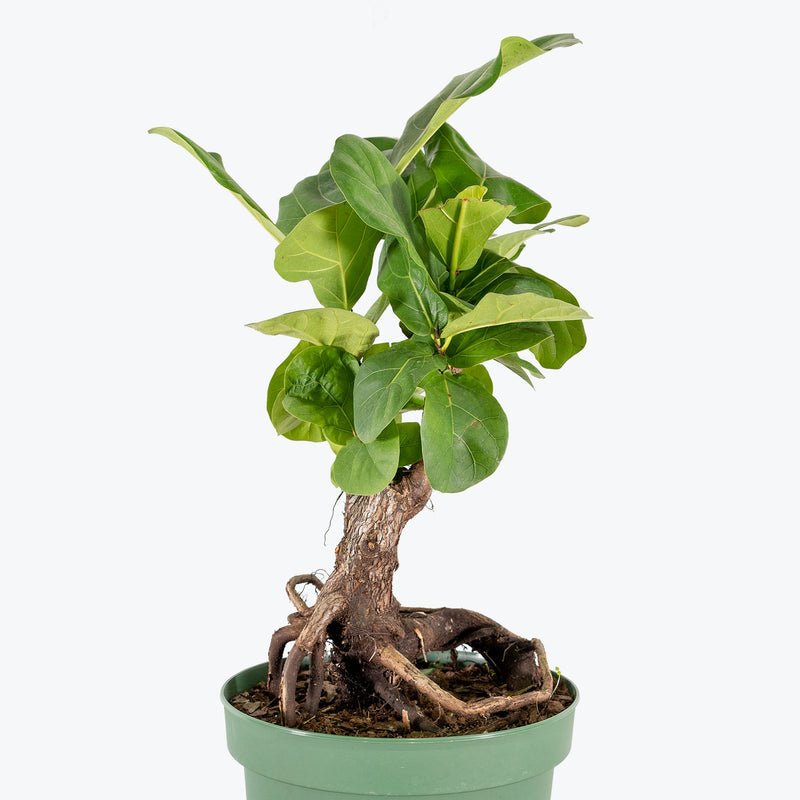
How to care for Fiddle Leaf Fig Bonsai
Fiddle Leaf Fig Bonsai enjoys some direct sun, but they'll also do well in bright, indirect light. It is best to place this plant somewhere where it will receive some nice morning sun, or a couple hours of afternoon sun, and then indirect light the rest of the day.
Fiddle Leaf Fig Bonsai will do best in bright light. A nice bright place inside your home would be on the window sill or a stool that is right next to a window, either with or without blinds, depending on if the plant can handle sun. Remember that plants will grow based on how much light they receive.
Fiddle Leaf Fig Bonsai likes the soil to be relatively dry before the next watering. That usually takes about 2 weeks in an average home environment. It will vary depending on the time of year, your environment and lighting conditions, but for them, it's always safer to underwater or water when you see signs of lack of water (i.e. droopy, floppy, or soft leaves). Water more often in the warmer months!
Fiddle Leaf Fig Bonsai can live in any average home humidity condition but would definitely thank if you if they were to receive a more humid environment.
Fiddle Leaf Fig Bonsais are happiest in a stable environment and should always be placed right in or near a window. Make environmental changes gradually and try not to move the plant in winter. Keep away from air conditioners, heaters and drafts.
Fiddle Leaf Fig Bonsai is moderately toxic and can cause some adverse reactions when ingested so it is best to not let your pets eat it, which we advise for all plants in general. The severity of the reaction will depend on how much of the plant is ingested but, if you know your pet typically does not eat your plants, this plant will be suitable for your home..
Learn MoreView PlantFiddle Leaf Fig Bush
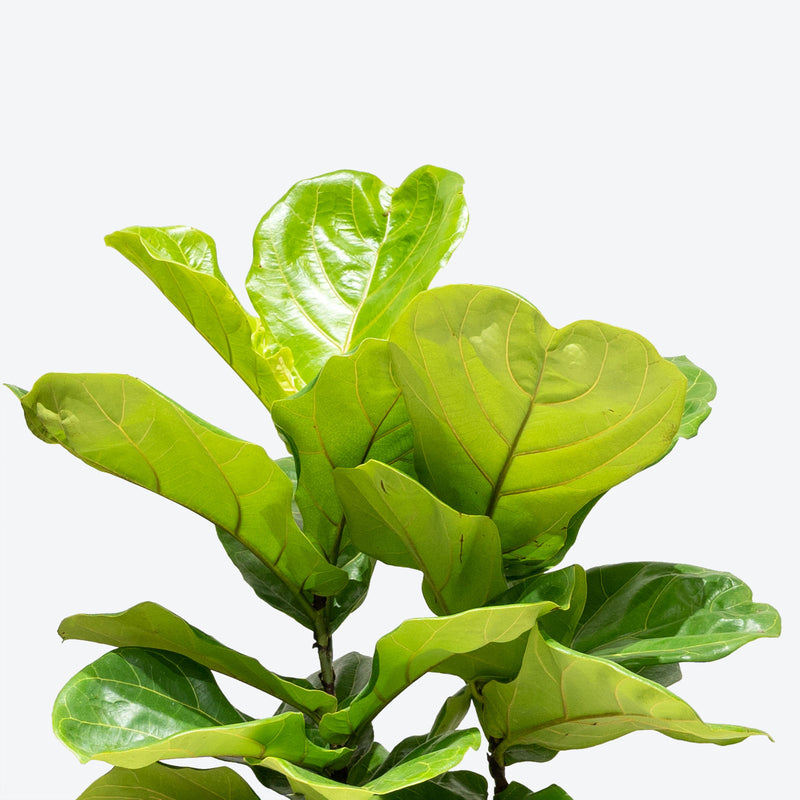
How to care for Fiddle Leaf Fig Bush
Fiddle Leaf Fig Bush enjoys some direct sun, but they'll also do well in bright, indirect light. It is best to place this plant somewhere where it will receive some nice morning sun, or a couple hours of afternoon sun, and then indirect light the rest of the day.
Fiddle Leaf Fig Bush will do best in bright light. A nice bright place inside your home would be on the window sill or a stool that is right next to a window, either with or without blinds, depending on if the plant can handle sun. Remember that plants will grow based on how much light they receive.
Fiddle Leaf Fig Bush likes the soil to be relatively dry before the next watering. That usually takes about 2 weeks in an average home environment. It will vary depending on the time of year, your environment and lighting conditions, but for them, it's always safer to underwater or water when you see signs of lack of water (i.e. droopy, floppy, or soft leaves). Water more often in the warmer months!
Fiddle Leaf Fig Bush can live in any average home humidity condition but would definitely thank if you if they were to receive a more humid environment.
Fiddle Leaf Fig Bushes are happiest in a stable environment and should always be placed right in or near a window. Make environmental changes gradually and try not to move the plant in winter. Keep away from air conditioners, heaters and drafts.
Fiddle Leaf Fig Bush is moderately toxic and can cause some adverse reactions when ingested so it is best to not let your pets eat it, which we advise for all plants in general. The severity of the reaction will depend on how much of the plant is ingested but, if you know your pet typically does not eat your plants, this plant will be suitable for your home..
Learn MoreView PlantFiddle Leaf Fig Column
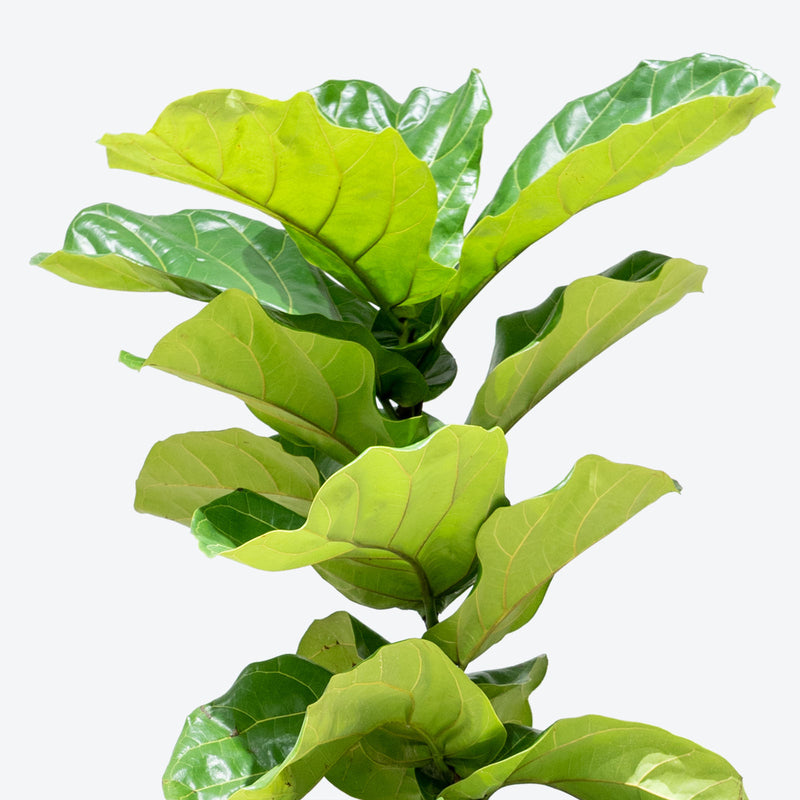
How to care for Fiddle Leaf Fig Column
Fiddle Leaf Fig Column enjoys some direct sun, but they'll also do well in bright, indirect light. It is best to place this plant somewhere where it will receive some nice morning sun, or a couple hours of afternoon sun, and then indirect light the rest of the day.
Fiddle Leaf Fig Column will do best in bright light. A nice bright place inside your home would be on the window sill or a stool that is right next to a window, either with or without blinds, depending on if the plant can handle sun. Remember that plants will grow based on how much light they receive.
Fiddle Leaf Fig Column likes the soil to be relatively dry before the next watering. That usually takes about 2 weeks in an average home environment. It will vary depending on the time of year, your environment and lighting conditions, but for them, it's always safer to underwater or water when you see signs of lack of water (i.e. droopy, floppy, or soft leaves). Water more often in the warmer months!
Fiddle Leaf Fig Column can live in any average home humidity condition but would definitely thank if you if they were to receive a more humid environment.
Fiddle Leaf Fig Columns are happiest in a stable environment and should always be placed right in or near a window. Make environmental changes gradually and try not to move the plant in winter. Keep away from air conditioners, heaters and drafts.
Fiddle Leaf Fig Column is moderately toxic and can cause some adverse reactions when ingested so it is best to not let your pets eat it, which we advise for all plants in general. The severity of the reaction will depend on how much of the plant is ingested but, if you know your pet typically does not eat your plants, this plant will be suitable for your home..
Learn MoreView PlantFiddle Leaf Fig Tree
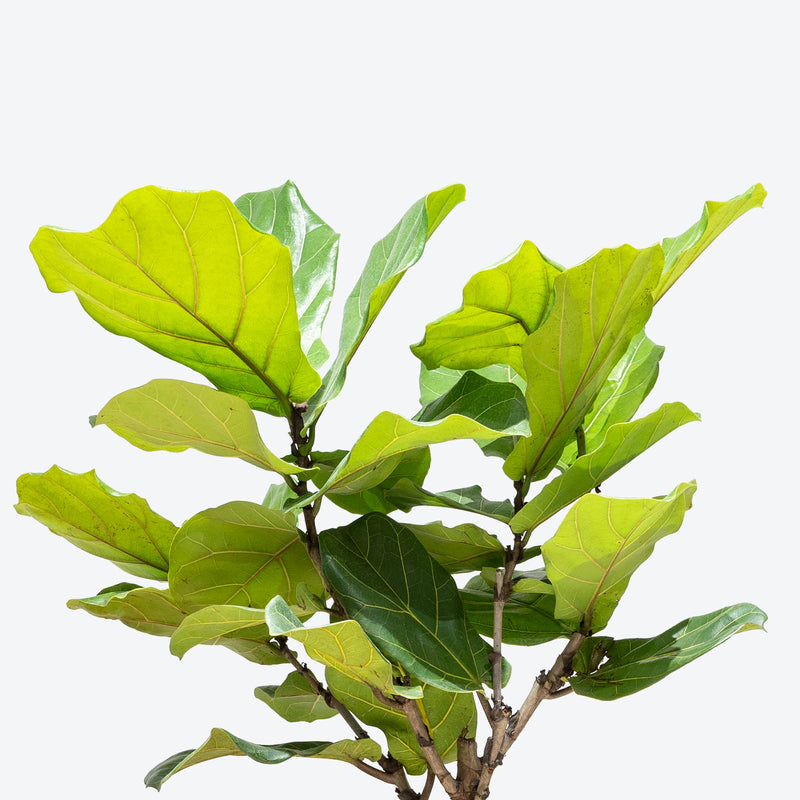
How to care for Fiddle Leaf Fig Tree
Fiddle Leaf Fig Tree enjoys some direct sun, but they'll also do well in bright, indirect light. It is best to place this plant somewhere where it will receive some nice morning sun, or a couple hours of afternoon sun, and then indirect light the rest of the day.
Fiddle Leaf Fig Tree will do best in bright light. A nice bright place inside your home would be on the window sill or a stool that is right next to a window, either with or without blinds, depending on if the plant can handle sun. Remember that plants will grow based on how much light they receive.
Fiddle Leaf Fig Tree likes the soil to be relatively dry before the next watering. That usually takes about 2 weeks in an average home environment. It will vary depending on the time of year, your environment and lighting conditions, but for them, it's always safer to underwater or water when you see signs of lack of water (i.e. droopy, floppy, or soft leaves). Water more often in the warmer months!
Fiddle Leaf Fig Tree can live in any average home humidity condition but would definitely thank if you if they were to receive a more humid environment.
Fiddle Leaf Fig Trees are happiest in a stable environment and should always be placed right in or near a window. Make environmental changes gradually and try not to move the plant in winter. Keep away from air conditioners, heaters and drafts.
Fiddle Leaf Fig Tree is moderately toxic and can cause some adverse reactions when ingested so it is best to not let your pets eat it, which we advise for all plants in general. The severity of the reaction will depend on how much of the plant is ingested but, if you know your pet typically does not eat your plants, this plant will be suitable for your home..
Learn MoreView PlantFirefly Leopard Plant
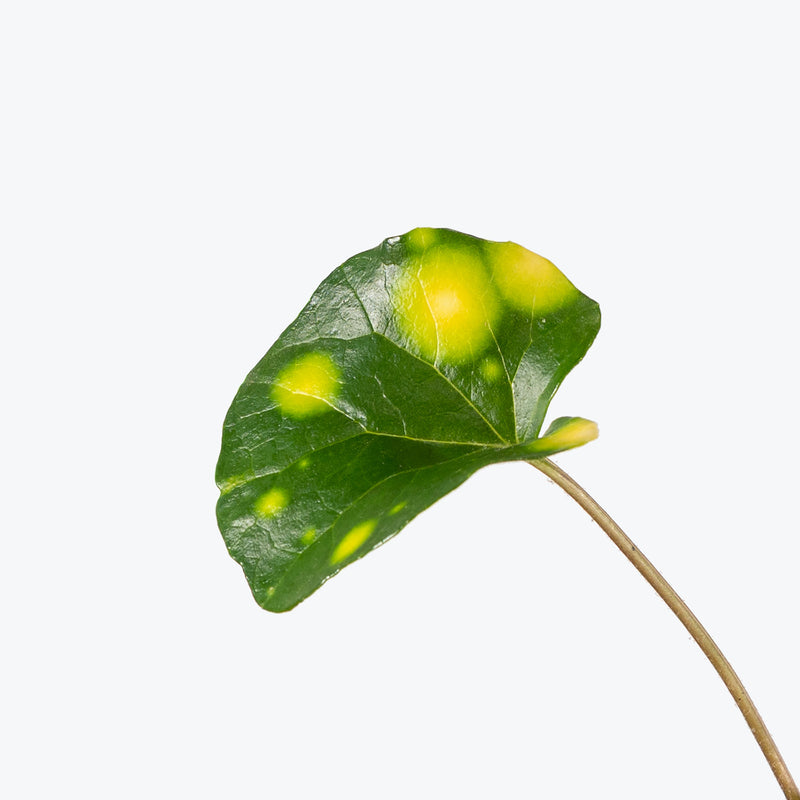
How to care for Firefly Leopard Plant
Firefly Leopard Plant should not be in a position to see the sun directly, although early morning or late evening sun is fine. Filtered sunlight through a sheer curtain is best and most homes are comprised primarily of indirect sunlight. The best spot for them is where they do not see the sun during the majority of the day but still get bright, indirect light.
Firefly Leopard Plant will thrive in bright light, but also can tolerate medium light. A good medium-light place in your home would be in the middle of a room that has a regular size window. They can be placed anywhere between the middle of the room and the window. Remember that plants will grow based on how much light they receive.
Allow the top quarter of the soil to dry before watering Firefly Leopard Plant again. This usually takes about 3 - 4 days in an average home environment. It will vary depending on the time of year, your environment and lighting conditions. Expect to water more often in brighter light and less often in lower light.
Firefly Leopard Plant will do well in average humidity environments but will appreciate a little bit of humidity if provided, give them a mist daily or get a humidifier.
To maintain the glossy, vibrant look, keep the soil consistently moist but not waterlogged. Mulch around the base outdoors to help lock in moisture. If grown indoors, Firefly Leopard Plant appreciates extra humidity — without it, the leaf edges may dry and brown. Fertilize lightly during the growing season with a balanced fertilizer every 4–6 weeks. If you notice the spotting fading or leaves becoming leggy, it's likely craving more light. Remove older leaves at the base to keep the plant looking tidy and encourage fresh growth. In colder climates, Firefly can be overwintered indoors or protected outside, as it doesn't tolerate hard freezes well.
Firefly Leopard Plant is moderately toxic and can cause some adverse reactions when ingested so it is best to not let your pets eat it, which we advise for all plants in general. The severity of the reaction will depend on how much of the plant is ingested but, if you know your pet typically does not eat your plants, this plant will be suitable for your home..
View PlantFishbone Cactus
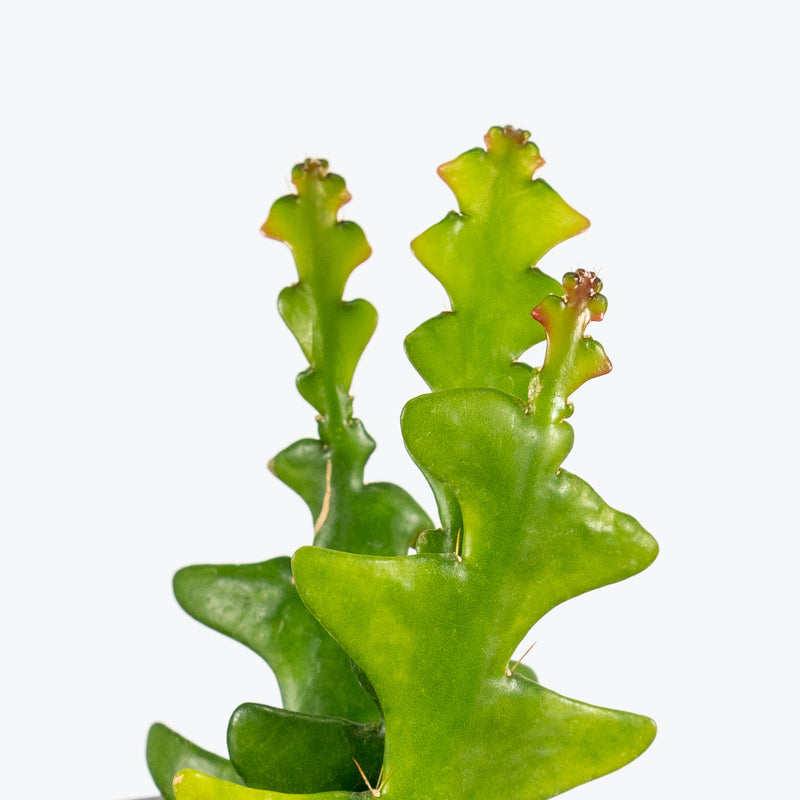
How to care for Fishbone Cactus
Fishbone Cactus enjoys some direct sun, but they'll also do well in bright, indirect light. It is best to place this plant somewhere where it will receive some nice morning sun, or a couple hours of afternoon sun, and then indirect light the rest of the day.
Fishbone Cactus will do best in bright light. A nice bright place inside your home would be on the window sill or a stool that is right next to a window, either with or without blinds, depending on if the plant can handle sun. Remember that plants will grow based on how much light they receive.
Fishbone Cactus likes the soil to be completely dry before the next watering. That usually takes about 4 weeks in an average home environment. It will vary depending on the time of year, your environment and lighting conditions, but for them, it's always safer to underwater or water when you see signs of lack of water (i.e. wrinkly or soft leaves). Water a little more often in the warmer months!
Fishbone Cactus humidity requirement is low, so do not mist them or put them in an enclosed terrarium.
Being an epiphyte, it benefits from being potted in a well-draining, orchid or cacti mix to mimic its natural growing conditions on tree branches. Pruning is rarely needed but can be done to maintain shape or control size. You don't need to worry about repotting fishbone cactus; it grows and blooms best when somewhat root bound. Only repot every four or five years.
Fishbone Cactus is moderately toxic and can cause some adverse reactions when ingested so it is best to not let your pets eat it, which we advise for all plants in general. The severity of the reaction will depend on how much of the plant is ingested but, if you know your pet typically does not eat your plants, this plant will be suitable for your home..
Learn MoreView PlantFishtail Palm
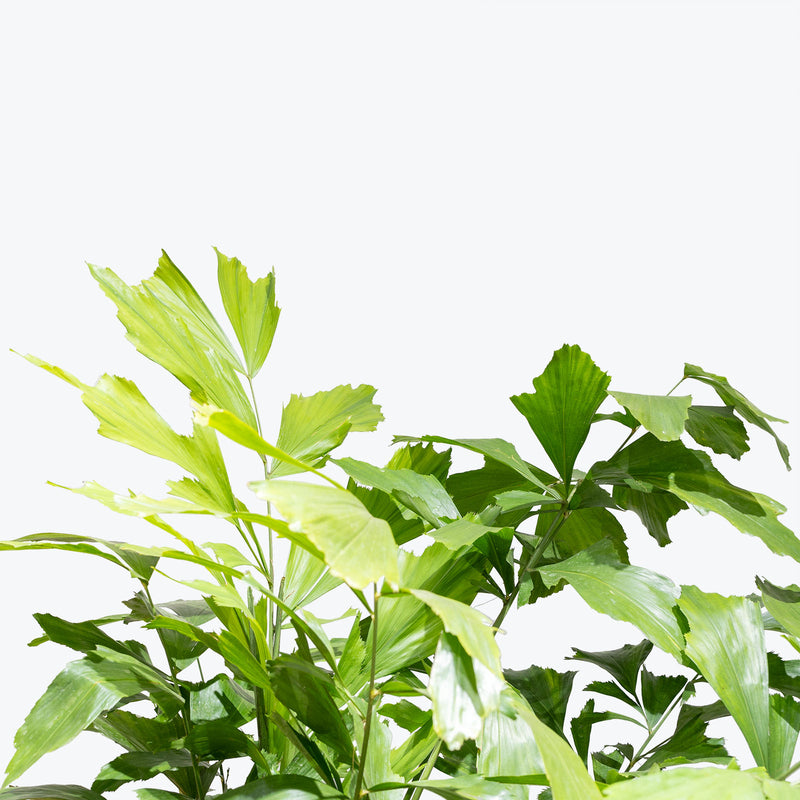
How to care for Fishtail Palm
Fishtail Palm should not be in a position to see the sun directly, although early morning or late evening sun is fine. Filtered sunlight through a sheer curtain is best and most homes are comprised primarily of indirect sunlight. The best spot for them is where they do not see the sun during the majority of the day but still get bright, indirect light.
Fishtail Palm will thrive in bright light, but also can tolerate medium light. A good medium-light place in your home would be in the middle of a room that has a regular size window. They can be placed anywhere between the middle of the room and the window. Remember that plants will grow based on how much light they receive.
Allow the top quarter of the soil to dry before watering again. This usually takes about 3 - 4 days in an average home environment. It will vary depending on the time of year, your environment and lighting conditions. Expect to water Fishtail Palm more often in brighter light and less often in lower light.
Fishtail Palm will do well in average humidity environments but will appreciate a little bit of humidity if provided, give them a mist daily or get a humidifier.
Fertilize your Fishtail Palm with a balanced liquid fertilizer during the growing season, about once a month. Clean the leaves occasionally to remove dust and help the plant photosynthesize effectively. As it grows, the lower leaves will naturally brown and die off; these should be trimmed to keep the plant looking tidy.
Fishtail Palm is moderately toxic and can cause some adverse reactions when ingested so it is best to not let your pets eat it, which we advise for all plants in general. The severity of the reaction will depend on how much of the plant is ingested but, if you know your pet typically does not eat your plants, this plant will be suitable for your home..
Learn MoreView PlantFittonia Flaming Red
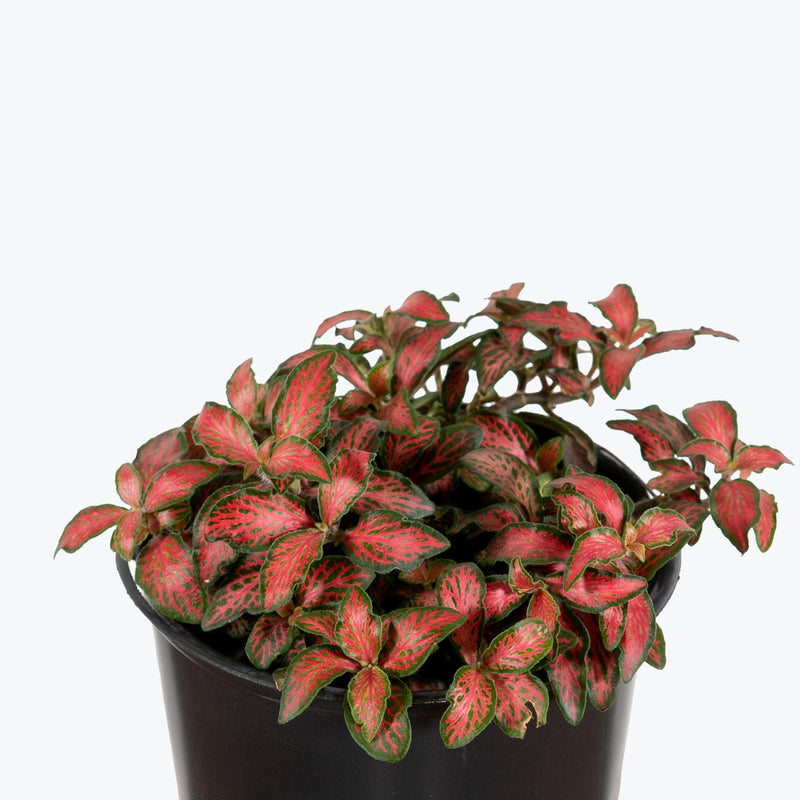
How to care for Fittonia Flaming Red
They should not be in a position to see the sun directly, although early morning or late evening sun is fine. Filtered sunlight through a sheer curtain is best and most homes are comprised primarily of indirect sunlight. The best spot for them is where they do not see the sun during the majority of the day but still get bright, indirect light.
They will do well in medium light but will grow faster with brighter light. A good medium-light place in your home would be in the middle of a room that has a regular size window. Remember that plants will grow based on how much light they receive.
Allow the top quarter of the soil to dry before watering again. This usually takes about 3 - 4 days in an average home environment. It will vary depending on the time of year, your environment and lighting conditions. Expect to water more often in brighter light and less often in lower light.
They will do well in average humidity environments but will appreciate a little bit of humidity if provided, give them a mist daily or get a humidifier.
If you let your Fittonia dry out too much, it will let you know with limp leaves. Not to worry! After a thorough watering, the leaves should soon perk up. Bonus: because this plant likes humidity, it will thrive in a terrarium, too!
You can feel comfortable having this plant around your home in the potential case where your pet feels like nibbling on it. However, we typically recommend keeping your pets from eating any of your houseplants..
View PlantFittonia Flammule
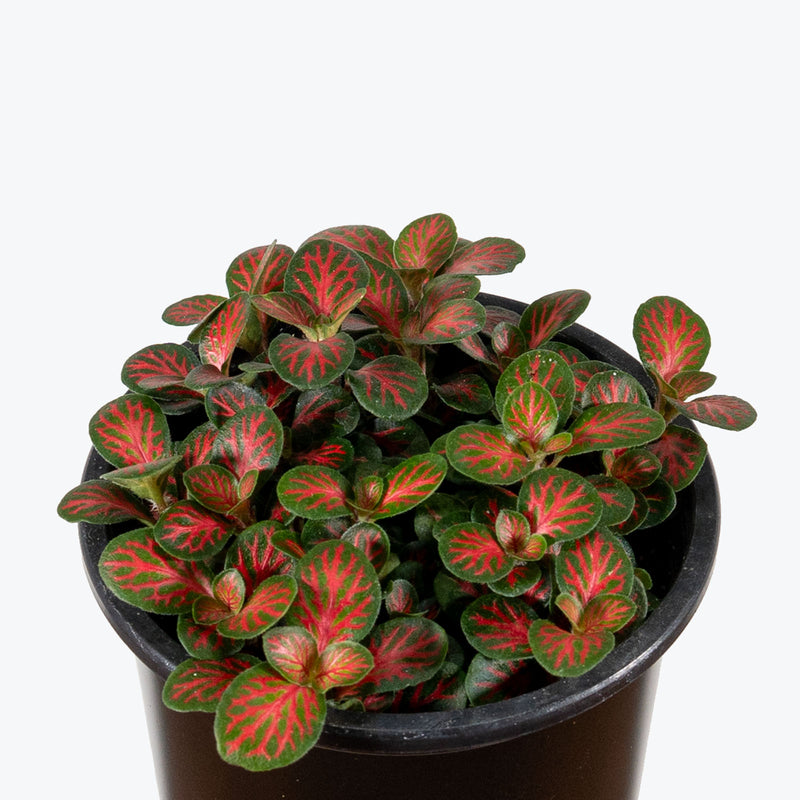
How to care for Fittonia Flammule
Fittonia Flammule should not be in a position to see the sun directly, although early morning or late evening sun is fine. Filtered sunlight through a sheer curtain is best and most homes are comprised primarily of indirect sunlight. The best spot for them is where they do not see the sun during the majority of the day but still get bright, indirect light.
Fittonia Flammule will thrive in bright light, but also can tolerate medium light. A good medium-light place in your home would be in the middle of a room that has a regular size window. They can be placed anywhere between the middle of the room and the window. Remember that plants will grow based on how much light they receive.
Allow the top quarter of the soil to dry before watering again. This usually takes about 3 - 4 days in an average home environment. It will vary depending on the time of year, your environment and lighting conditions. Expect to water Fittonia Flammule more often in brighter light and less often in lower light.
Fittonia Flammule will do well in average humidity environments but will appreciate a little bit of humidity if provided, give them a mist daily or get a humidifier.
If you let your Fittonia Flammule dry out too much, it will let you know with limp leaves. Not to worry! After a thorough watering, the leaves should soon perk up. Bonus: because this plant likes humidity, it will thrive in a terrarium, too! Pinch back the tips of the stems regularly to encourage a bushier growth and prevent the plant from becoming leggy. Clean the leaves occasionally to remove dust.
You can feel comfortable having Fittonia Flammule around your home in the potential case where your pet feels like nibbling on it. However, we typically recommend keeping your pets from eating any of your houseplants..
View PlantFittonia Forest
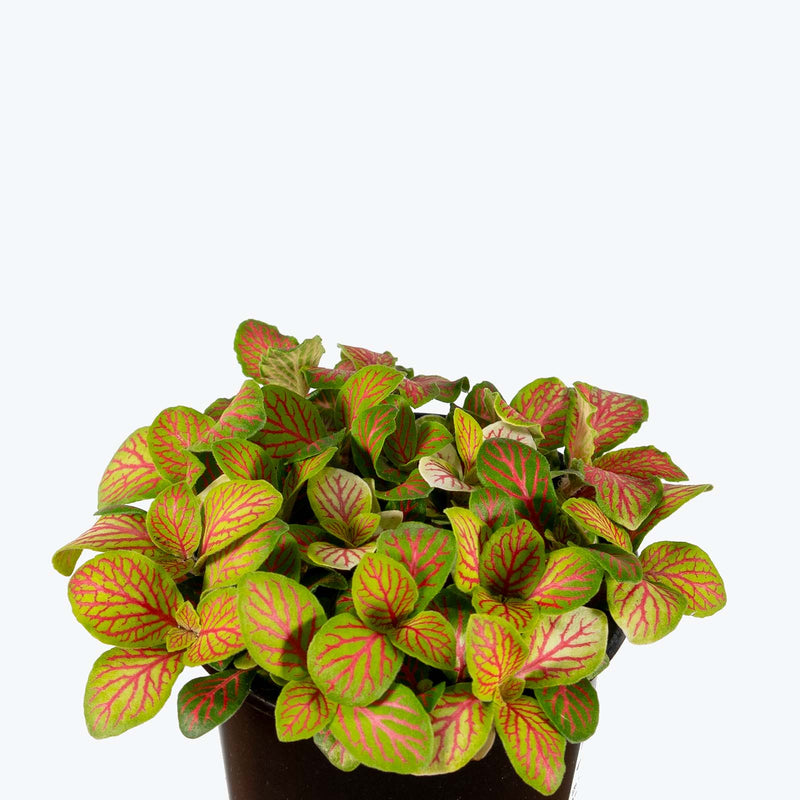
How to care for Fittonia Forest
Fittonia Forest should not be in a position to see the sun directly, although early morning or late evening sun is fine. Filtered sunlight through a sheer curtain is best and most homes are comprised primarily of indirect sunlight. The best spot for them is where they do not see the sun during the majority of the day but still get bright, indirect light.
Fittonia Forest will thrive in bright light, but also can tolerate medium light. A good medium-light place in your home would be in the middle of a room that has a regular size window. They can be placed anywhere between the middle of the room and the window. Remember that plants will grow based on how much light they receive.
Allow the top quarter of the soil to dry before watering Fittonia Skeleton again. This usually takes about 3 - 4 days in an average home environment. It will vary depending on the time of year, your environment and lighting conditions. Expect to water Fittonia Forest more often in brighter light and less often in lower light.
Fittonia Forest will do well in average humidity environments but will appreciate a little bit of humidity if provided, give them a mist daily or get a humidifier.
Fittonia Forest benefits from regular pruning to encourage bushier growth and prevent it from becoming leggy. If you let your Fittonia Skeleton dry out too much, it will let you know with limp leaves. Not to worry! After a thorough watering, the leaves should soon perk up. Bonus: because this plant likes humidity, it will thrive in a terrarium, too!
You can feel comfortable having Fittonia Forest around your home in the potential case where your pet feels like nibbling on it. However, we typically recommend keeping your pets from eating any of your houseplants..
View PlantFittonia Frankie
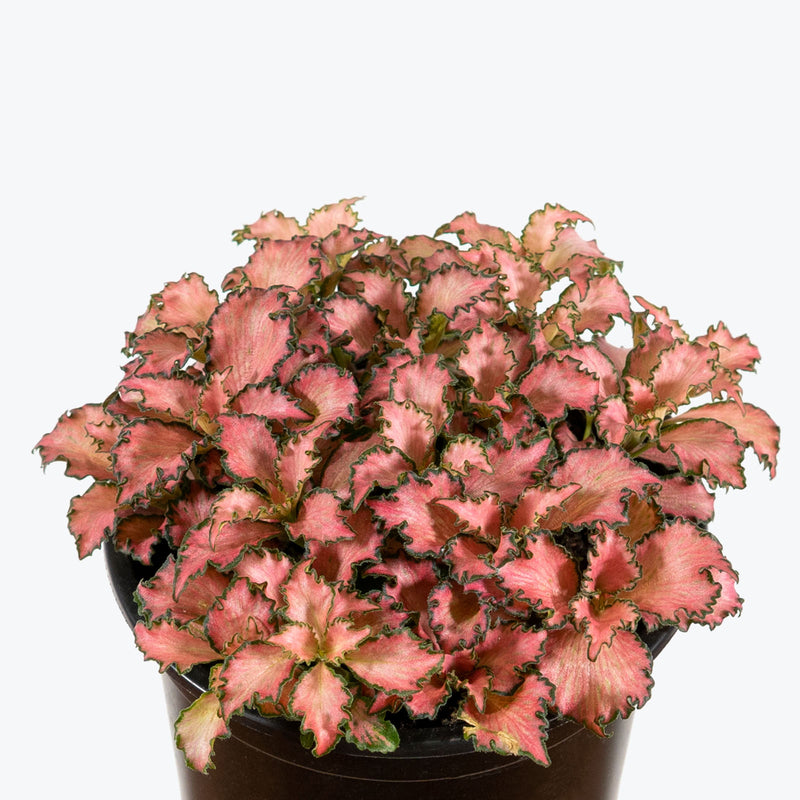
How to care for Fittonia Frankie
They should not be in a position to see the sun directly, although early morning or late evening sun is fine. Filtered sunlight through a sheer curtain is best and most homes are comprised primarily of indirect sunlight. The best spot for them is where they do not see the sun during the majority of the day but still get bright, indirect light.
They will thrive in bright light, but also can tolerate medium light. A good medium-light place in your home would be in the middle of a room that has a regular size window. They can be placed anywhere between the middle of the room and the window. Remember that plants will grow based on how much light they receive.
Allow the top quarter of the soil to dry before watering again. This usually takes about 3 - 4 days in an average home environment. It will vary depending on the time of year, your environment and lighting conditions. Expect to water more often in brighter light and less often in lower light.
They will do well in average humidity environments but will appreciate a little bit of humidity if provided, give them a mist daily or get a humidifier.
If you let your Fittonia dry out too much, it will let you know with limp leaves. Not to worry! After a thorough watering, the leaves should soon perk up but try not to let this happen too often. If your plant ever starts to appear leggy or stretched out, trim off the stretched pieces and place it in bright light, new growth will form where the plant was trimmed. Bonus: because this plant likes humidity, it will thrive in a terrarium, too!
You can feel comfortable having this plant around your home in the potential case where your pet feels like nibbling on it. However, we typically recommend keeping your pets from eating any of your houseplants..
View PlantFittonia Nerve Plant
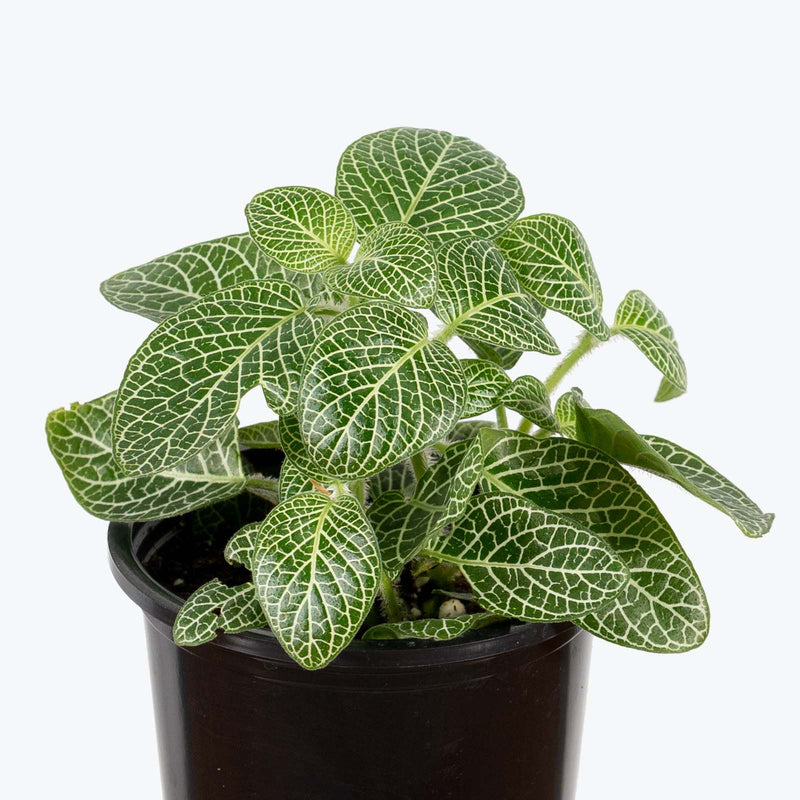
How to care for Fittonia Nerve Plant
Fittonia Nerve Plant should not be in a position to see the sun directly, although early morning or late evening sun is fine. Filtered sunlight through a sheer curtain is best and most homes are comprised primarily of indirect sunlight. The best spot for them is where they do not see the sun during the majority of the day but still get bright, indirect light.
Fittonia Nerve Plant will thrive in bright light, but also can tolerate medium light. A good medium-light place in your home would be in the middle of a room that has a regular size window. They can be placed anywhere between the middle of the room and the window. Remember that plants will grow based on how much light they receive.
Allow the top quarter of the soil to dry before watering the Fittonia Nerve Plant again. This usually takes about 3 - 4 days in an average home environment. It will vary depending on the time of year, your environment and lighting conditions.
Fittonia Nerve Plant will do well in average humidity environments but will appreciate a little bit of humidity if provided, give them a mist daily or get a humidifier!
If you let your Fittonia Nerve Plant dry out too much, it will let you know with limp leaves. Not to worry! After a thorough watering, the leaves should soon perk up. Bonus: because this plant likes humidity, it will thrive in a terrarium, too!
You can feel comfortable having Fittonia Nerve Plant around your home in the potential case where your pet feels like nibbling on it. However, we typically recommend keeping your pets from eating any of your houseplants..
View PlantFittonia Pink Forest Flame

How to care for Fittonia Pink Forest Flame
Fittonia Pink Forest Flame should not be in a position to see the sun directly, although early morning or late evening sun is fine. Filtered sunlight through a sheer curtain is best and most homes are comprised primarily of indirect sunlight. The best spot for them is where they do not see the sun during the majority of the day but still get bright, indirect light.
Fittonia Pink Forest Flame will thrive in bright light, but also can tolerate medium light. A good medium-light place in your home would be in the middle of a room that has a regular size window. They can be placed anywhere between the middle of the room and the window. Remember that plants will grow based on how much light they receive.
Allow the top quarter of the soil to dry before watering Fittonia Pink Forest Flame again. This usually takes about 3 - 4 days in an average home environment. It will vary depending on the time of year, your environment and lighting conditions. Expect to water more often in brighter light and less often in lower light.
Fittonia Pink Forest Flame will do well in average humidity environments but will appreciate a little bit of humidity if provided, give them a mist daily or get a humidifier.
If you let your Fittonia Pink Forest Flame dry out too much, it will let you know with limp leaves. Not to worry! After a thorough watering, the leaves should soon perk up. Pinch back the tips of the stems regularly to encourage a bushier growth habit and to prevent the plant from becoming leggy. Clean the leaves occasionally with a soft, damp cloth to remove dust.
You can feel comfortable having Fittonia Pink Forest Flame around your home in the potential case where your pet feels like nibbling on it. However, we typically recommend keeping your pets from eating any of your houseplants..
View PlantFittonia Red Cloud
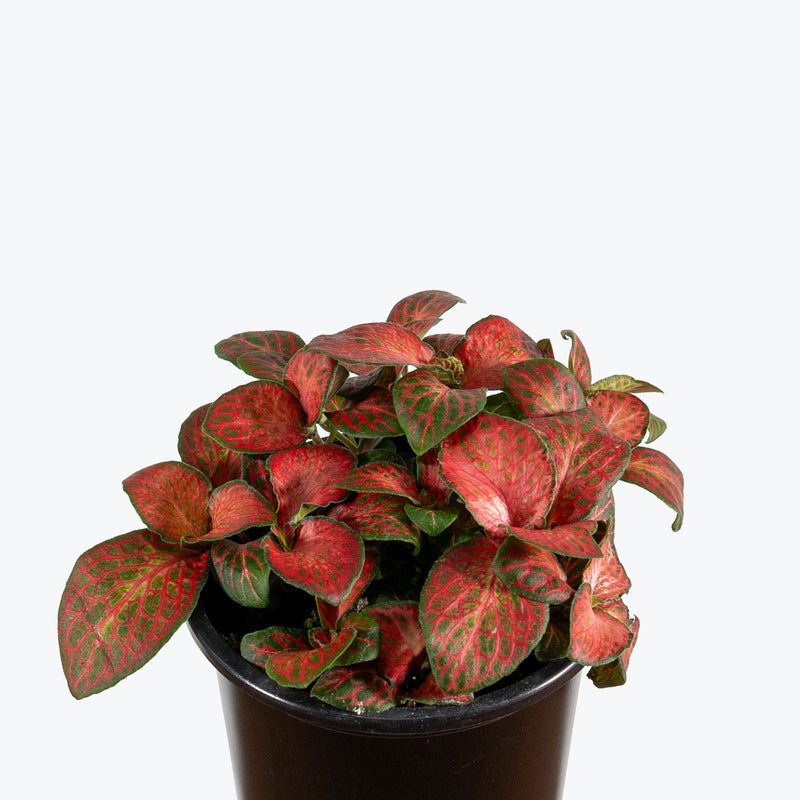
How to care for Fittonia Red Cloud
Fittonia Red Cloud should not be in a position to see the sun directly, although early morning or late evening sun is fine. Filtered sunlight through a sheer curtain is best and most homes are comprised primarily of indirect sunlight. The best spot for them is where they do not see the sun during the majority of the day but still get bright, indirect light.
Fittonia Red Cloud will do well in medium light but will grow faster with brighter light. A good medium-light place in your home would be in the middle of a room that has a regular size window. Remember that plants will grow based on how much light they receive.
Allow the top quarter of the soil to dry before watering again. This usually takes about 3 - 4 days in an average home environment. It will vary depending on the time of year, your environment and lighting conditions. Expect to water Fittonia Red Cloud more often in brighter light and less often in lower light.
Fittonia Red Cloud will do well in average humidity environments but will appreciate a little bit of humidity if provided, give them a mist daily or get a humidifier.
If you let your Fittonia Red Cloud dry out too much, it will let you know with limp leaves. Not to worry! After a thorough watering, the leaves should soon perk up. Bonus: because this plant likes humidity, it will thrive in a terrarium, too!
You can feel comfortable having Fittonia Red Cloud around your home in the potential case where your pet feels like nibbling on it. However, we typically recommend keeping your pets from eating any of your houseplants..
View PlantFittonia Skeleton
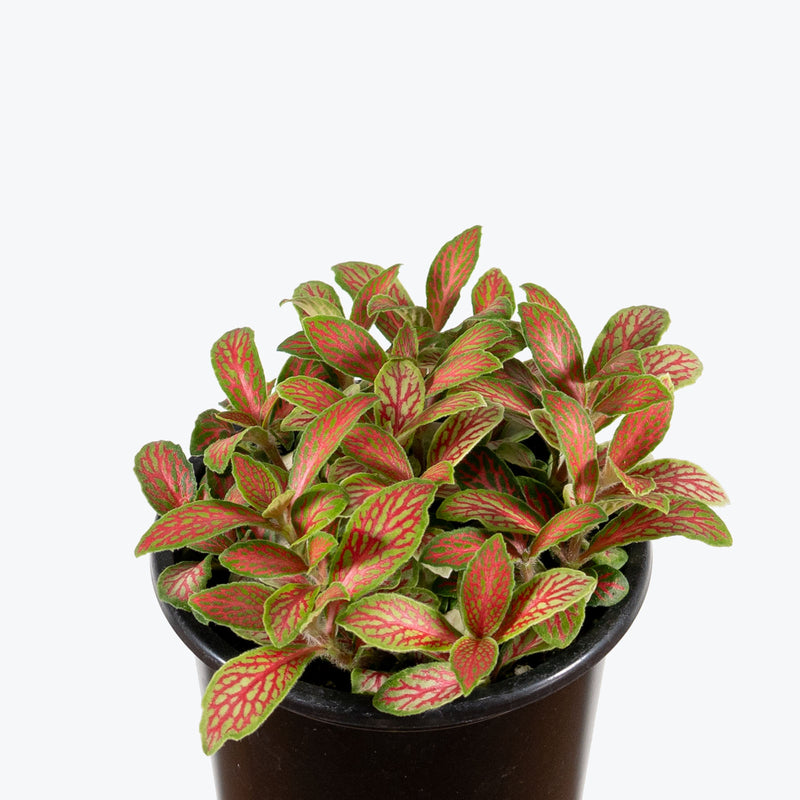
How to care for Fittonia Skeleton
Fittonia Skeleton should not be in a position to see the sun directly, although early morning or late evening sun is fine. Filtered sunlight through a sheer curtain is best and most homes are comprised primarily of indirect sunlight. The best spot for them is where they do not see the sun during the majority of the day but still get bright, indirect light.
Fittonia Skeleton will thrive in bright light, but also can tolerate medium light. A good medium-light place in your home would be in the middle of a room that has a regular size window. They can be placed anywhere between the middle of the room and the window. Remember that plants will grow based on how much light they receive.
Allow the top quarter of the soil to dry before watering Fittonia Skeleton again. This usually takes about 3 - 4 days in an average home environment. It will vary depending on the time of year, your environment and lighting conditions. Expect to water Fittonia Skeleton more often in brighter light and less often in lower light.
Fittonia Skeleton will do well in average humidity environments but will appreciate a little bit of humidity if provided, give them a mist daily or get a humidifier.
Fittonia Skeleton benefits from regular pruning to encourage bushier growth and prevent it from becoming leggy. If you let your Fittonia Skeleton dry out too much, it will let you know with limp leaves. Not to worry! After a thorough watering, the leaves should soon perk up. Bonus: because this plant likes humidity, it will thrive in a terrarium, too!
You can feel comfortable having Fittonia Skeleton around your home in the potential case where your pet feels like nibbling on it. However, we typically recommend keeping your pets from eating any of your houseplants..
View PlantFittonia Superba
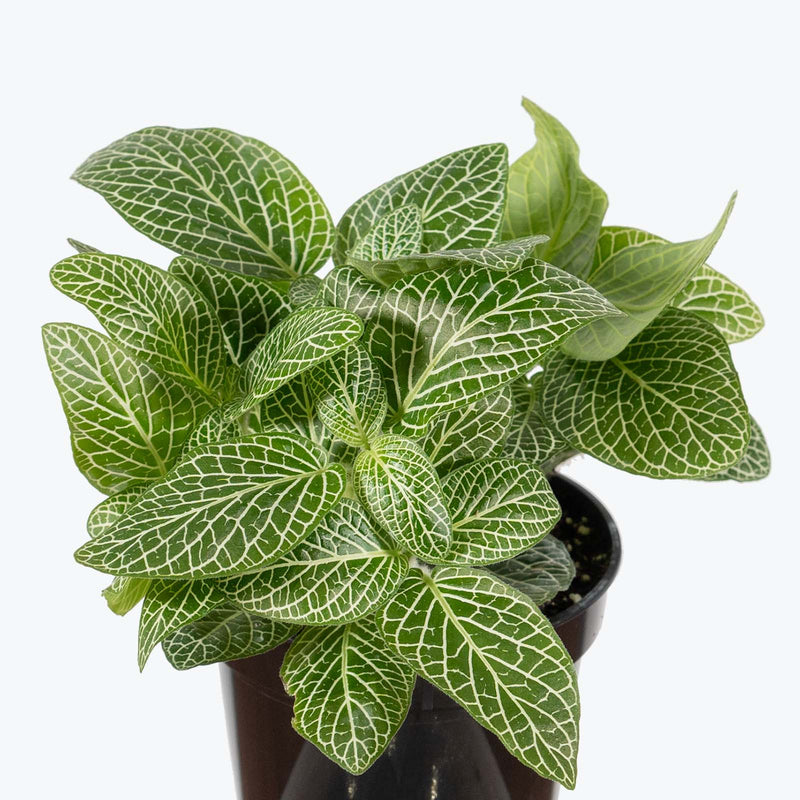
How to care for Fittonia Superba
They should not be in a position to see the sun directly, although early morning or late evening sun is fine. Filtered sunlight through a sheer curtain is best and most homes are comprised primarily of indirect sunlight. The best spot for them is where they do not see the sun during the majority of the day but still get bright, indirect light.
They will thrive in bright light, but also can tolerate medium light. A good medium-light place in your home would be in the middle of a room that has a regular size window. They can be placed anywhere between the middle of the room and the window. Remember that plants will grow based on how much light they receive.
Allow the top quarter of the soil to dry before watering again. This usually takes about 3 - 4 days in an average home environment. It will vary depending on the time of year, your environment and lighting conditions. Expect to water more often in brighter light and less often in lower light.
They will do well in average humidity environments but will appreciate a little bit of humidity if provided, give them a mist daily or get a humidifier.
If you let your Fittonia dry out too much, it will let you know with limp leaves. Not to worry! After a thorough watering, the leaves should soon perk up. With a quick pruning of any leggy or stretched-out pieces, your plant will stay nice and compact. Bonus: because this plant likes humidity and it will thrive in a terrarium.
You can feel comfortable having this plant around your home in the potential case where your pet feels like nibbling on it. However, we typically recommend keeping your pets from eating any of your houseplants..
View PlantFittonia White Anne

How to care for Fittonia White Anne
Fittonia White Anne should not be in a position to see the sun directly, although early morning or late evening sun is fine. Filtered sunlight through a sheer curtain is best and most homes are comprised primarily of indirect sunlight. The best spot for them is where they do not see the sun during the majority of the day but still get bright, indirect light.
Fittonia White Anne will thrive in bright light, but also can tolerate medium light. A good medium-light place in your home would be in the middle of a room that has a regular size window. They can be placed anywhere between the middle of the room and the window. Remember that plants will grow based on how much light they receive.
Allow the top quarter of the soil to dry before watering again. This usually takes about 3 - 4 days in an average home environment. It will vary depending on the time of year, your environment and lighting conditions. Expect to water Fittonia White Anne more often in brighter light and less often in lower light.
Fittonia White Anne will do well in average humidity environments but will appreciate a little bit of humidity if provided, give them a mist daily or get a humidifier.
If you let your Fittonia White Anne dry out too much, it will let you know with limp leaves. Not to worry! After a thorough watering, the leaves should soon perk up. With a quick pruning of any leggy or stretched-out pieces, your plant will stay nice and compact. Bonus: because this plant likes humidity and it will thrive in a terrarium. Regularly pinching back the tips of the stems encourages a fuller, bushier plant and prevents it from becoming leggy. Regularly clean the leaves to remove dust and enhance the plant's ability to photosynthesize effectively.
You can feel comfortable having Fittonia White Anne around your home in the potential case where your pet feels like nibbling on it. However, we typically recommend keeping your pets from eating any of your houseplants..
View PlantFukien Tea Bonsai
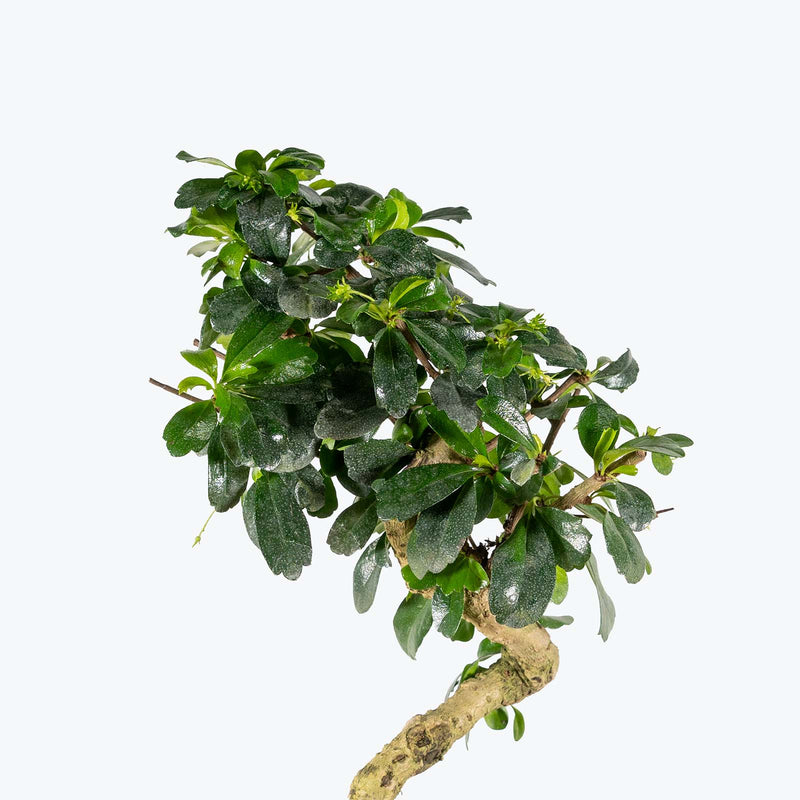
How to care for Fukien Tea Bonsai
Fukien Tea Bonsai enjoys some direct sun, but they'll also do well in bright, indirect light. It is best to place this plant somewhere where it will receive some nice morning sun, or a couple hours of afternoon sun, and then indirect light the rest of the day.
Fukien Tea Bonsai will do best in bright light. A nice bright place inside your home would be on the window sill or a stool that is right next to a window, either with or without blinds, depending on if the plant can handle sun. Remember that plants will grow based on how much light they receive.
Allow the top quarter of the soil to dry before watering again. This usually takes about 3 - 4 days in an average home environment. It will vary depending on the time of year, your environment and lighting conditions. Expect to water more often in brighter light and less often in lower light.
Fukien Tea Bonsai likes a high humidity environment, give them a mist daily or as often as possible. Alternatively, you can put them around a humidifier. Although they won't die if they don't receive enough humidity, their leaves may have some dry, crunchy, or yellow edges.
Regular pruning Fukien Tea Bonsai is needed to maintain its shape and encourage denser foliage. Prune back to 2-4 leaves after 6-8 leaves have grown. Use a balanced liquid fertilizer every two weeks during the growing season and monthly during the winter. Repot every two years in the spring, using well-draining soil mix designed for bonsai. Watch for pests like aphids and spider mites. Treat infestations immediately with appropriate measures.
Fukien Tea Bonsai is moderately toxic and can cause some adverse reactions when ingested so it is best to not let your pets eat it, which we advise for all plants in general. The severity of the reaction will depend on how much of the plant is ingested but, if you know your pet typically does not eat your plants, this plant will be suitable for your home..
View Plant



